This list of the Cenozoic life of Washington contains the various prehistoric life-forms whose fossilized remains have been reported from within the US state of Washington and are between 66 million and 10,000 years of age.
Chlorophytes
- Botryococcus
- Undescribed Late Pleistocene Manis Mastodon site subfossil[1]
- Pediastrum
- Undescribed Late Pleistocene Manis Mastodon site subfossil[1]
Diatoms
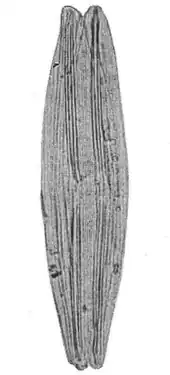
Frustulia rhomboides
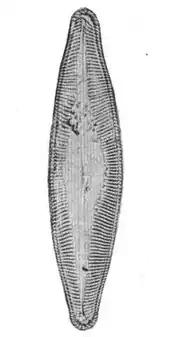
Navicula contendens
- Actinella
- Actinella brasiliensis[2]
- Amphipleura
- Amphipleura oregonica[2]
- Aulacoseira
- Caloneis
- Caloneis westii[2]
- Cavinula
- Cavinula scutiformis[2]
- Coscinodiscus
- Coscinodiscus subaulacodiscoidalis[2]
- Cymbella
- Desmogonium
- Desmogonium rabenhorstianum[2]
- Diatoma
- Eunotia
- Fragilaria
- Frustulia
- Frustulia rhomboides[2]
- Gomphogramma
- Gomphogramma rupestre[2]
- Gomphonema
- Himantidium
- Melosira
- Navicula
- Navicula americana[2]
- Navicula angusta[2]
- Navicula bacillum[2]
- Navicula commutata[2]
- †Navicula contendens - type locality for species[2]
- Navicula elegans[2]
- Navicula instabilis[2]
- †Navicula pauper - type locality for species[2]
- Navicula placentula[2]
- †Navicula pontifica - type locality for species[2]
- †Navicula protrudens - type locality for species[2]
- †Navicula pseudoaffinis - type locality for species[2]
- Navicula pseudobacillum[2]
- Navicula pusilla[2]
- Navicula radiosa[2]
- †Navicula reversa - type locality for species[2]
- Navicula stauroptera[2]
- Navicula subacuta[2]
- †Navicula substauroneis - type locality for species[2]
- Navicula tabellaria[2]
- Navicula transversa[2]
- Navicula viridis[2]
- Neidium
- Pinnularia
- Stauroneis
- Surirella
- Tabellaria
- Tetracyclus
Foraminifera
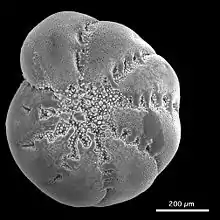
Test of Elphidium
- Amphimorphina
- †Amphimorphina californica
- Amphistegina
- undescribed Eocene Crescent Formation fossil(s)
- Bulimina
- Cf. †Bulimina jacksonensis
- Cassidulina
- Cf. †Cassidulina galvinensis
- Chilostomella
- Cf. †Chilostomella oolina
- Cibicides
- †Cibicides cushmani
- †Cibicides midwayensis
- Cibicidoides
- †Cibicidoides coalingensis
- Dentalina
- Eggerella
- Cf. †Eggerella bradyi
- Elphidium
- Eponides
- †Eponides mexicana
- †Eponides yeguaensis
- Gaudryina
- †Gaudryina jacksonensis
- Globigerina
- Undescribed Late Eocene Whiskey Creek methane-seep fossil
- 'Globobulimina
- †Globobulimina pacifica
- Globocassidulina
- †Globocassidulina globosa
- Guttulina
- †Guttulina frankei
- Gyroidina
- †Gyroidina orbicularis
- Haplophragmoides
- Undescribed Late Eocene Whiskey Creek methane-seep fossil
- †Involutina
- Cf. †Involutina incertus
- Lenticulina
- Lenticulina rancocasensis
- Undescribed Late Eocene Whiskey Creek methane-seep fossil
- Undescribed Ypresian Crescent Formation fossil
- Marginulina
- †Marginulina subbulata
- Martinottiella
- †Martinottiella communis
- Plectofrondicularia
- Cf. †Plectofrondicularia vaughani
- †Pseudoglandulina
- Cf. †Pseudoglandulina inflata
- Pyrgo (genus)
- Cf. †Pyrgo lupheri
- Quinqueloculina
- †Quinqueloculina imperalis
- †Quinqueloculina imperialis
- Robulus
- Sigmomorphina
- †Sigmomorphina schencki
- 'Uvigerina
- †Uvigerina garzaensis
Plants
Bryophytes

Hypnites patens moss holotype
"Ferns" (Polypodiophyta)

A fossilized frond found in Whatcom County from the Eocene tree fern Cyathea inequilateralis
- Adiantum[6]
- †Adiantum anastomosum - type locality for species[6]
- †Allantodiopsis
- Anemia[7]
- †Anemia elongata[7]
- Asplenium
- Cf. †Asplenium delicata
- Athyrium
- †Athyrium gracilium - type locality for species[7]
- †Azolla
- Cheilanthes
- Undescribed Late Pleistocene Manis Mastodon site subfossil(s)[1]
- Cyathea
- Cf. Cystopteris
- Undescribed Ypresian Klondike Mountain Formation fossil(s)[12]
- Danaea
- †Danaea borealis - type locality for species[7]
- Dennstaedtia
- †Dennstaedtia christophelii - type locality for species[13]
- †Dennstaedtia delicata - type locality for species[7]
- †Dryophyllum
- †Dryophyllum pugetensis – type locality for species[8]
- Dryopteris
- †Equisetum
- †Equisetum alexanderi - type locality for species[14]
- †Equisetum newberryi - type locality for species[7]
- Undescribed Klondike Mountain Formation fossils[15]
- Hymenophyllum
- †Hymenophyllum axsmithii - type locality for species[13]
- Lygodium
- †Lygodium kaulfussi[16]
- Undescribed Ypresian Klondike Mountain Formation fossil[12][17]
- Osmunda[18]
- †Osmunda occidentalis - type locality for species[14]
- †Osmunda wehrii - type locality for species[18]
- Pteris
- †Pteris whatcomensis -type locality for species[7]
- Salpichlaena[7]
- †Salpichlaena serrata[7]
- Salvinia
- Cf. †Salvinia preauriculata
- Undescribed Klondike Mountain Formation fossil[19]
Lycophytes
- Lycopodium
- Selaginella
- Undescribed Klondike Mountain Formation fossil[12][9]
Ginkgophytes
- Ginkgo
- †Ginkgo adiantoides[5]
- †Ginkgo beckii - type locality of the species[20]
- Ginkgo biloba[21]
- †Ginkgo dissecta[21]
Gnetophytes
- Ephedra
- Undescribed Late Pleistocene Manis Mastodon site subfossil(s)[1]
Pinophytes
Cupressaceae
- Calocedrus
- Undescribed Ypresian Klondike Mountain Formation fossil(s)[22][23]
- Chamaecyparis
- †Chamaecyparis linguaefolia[9]
- Undescribed Ypresian Klondike Mountain Formation fossil(s)[24][25]
- Cryptomeria
- Undescribed Ypresian Klondike Mountain Formation fossil(s)[24][17]
- †Cupressinoxylon
- Glyptostrobus
- †Glyptostrobus nordenskiöldii[7][27]
- Undescribed Ypresian Klondike Mountain Formation fossil[24]
- Metasequoia
- Sequoia
- Taiwania
- Undescribed Ypresian Klondike Mountain Formation fossil[19]
- Taxodium
- †Taxodioxylon
- Tetraclinis
- Tetraclinis salicornioides var. praedecurrens - type locality for the species[31]
- Thuja
- †Thuja dimorpha[32]
- Undescribed Ypresian Klondike Mountain Formation fossil[24][25]
- Thujopsis?
- Undescribed Ypresian Klondike Mountain Formation fossil[25]
Pinaceae
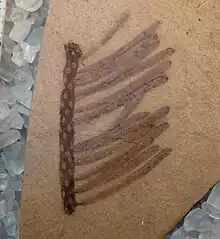
Abies milleri twig and foliage

Pseudolarix wehrii wing seed
- Abies
- Abies milleri - type locality for the species[33]
- Undescribed Miocene Vantage flora petrified woods.[6]
- Undescribed Late Pleistocene Manis Mastodon site subfossil(s)[1]
- Cedrus
- Undescribed middle Miocene Vasa Park fossil(s)[9]
- Keteleeria
- †Keteleeria heterophylloides - type locality for the species[34]
- Picea[9]
- †Picea tertiarum - type locality for the species[30][26]
- Undescribed Ypresian Klondike Mountain Formation fossils[24]
- Pinus[9]
- Pseudolarix
- Pseudotsuga
- †Pseudotsuga pseudotsugae - type locality for the species[26]
- Tsuga
Sciadopityaceae
- Sciadopitys
- Undescribed Klondike Mountain Formation fossil[24]
Taxaceae
- Amentotaxus
- undescribed Ypresian Klondike Mountain Formation fossil(s)[24]
- Cephalotaxus
- †Cephalotaxus bonseri - type locality for species[29][37]
- Undescribed Ypresian Klondike Mountain Formation fossil(s)[24]
- Taxus
- Undescribed Ypresian Klondike Mountain Formation fossil[24]
- Undescribed Middle Miocene Vantage fossils(s)[26]
Angiosperms
Plants A
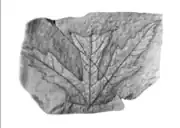
Fossilized leaf found near Spokane; the holotype specimen of the Oligocene-Miocene maple tree Acer chaneyi
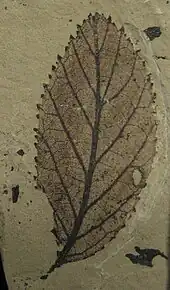
Fossilized leaf found in Republic from the Eocene Alder species Alnus parvifolia
- Acer[9]
- †"Acer" arcticum
- †Acer beckianum - type locality for species[38]
- †Acer bendirei[39]
- †Acer berkhoffii - type locality for species (syn =Aceroxylon pennsylvanicum)[26]
- †Acer browni[40]
- †Acer chaneyi[40]
- †Acer hillsi - type locality for species[40]
- †Acer knolli - type locality for species[40]
- †Acer latahense - type locality for species[40]
- †Acer medianum[40]
- †Acer niklasi[40]
- †Acer olearyi - type locality for species[38]
- †Acer puratanum - type locality for species[38]
- †Acer republicense - type locality for species[40]
- †Acer spitzi - type locality for species[40]
- †Acer stonebergae[40]
- †Acer tigilense[40]
- †Acer toradense - type locality for species[40]
- †Acer washingtonense - type locality for species[40]
- †Acer wehri - type locality for the species[40]
- †Acer whitebirdense[40]
- Aesculus[9]
- †Aesculus hankinsii - type locality for species[41]
- Undescribed Ypresian Klondike Mountain Formation fossil(s)[22][42]
- Albizzia
- †Allophylus
- Cf. †Allophylus duktothensis
- Alnus
- Amelanchier
- undescribed Ypresian Klondike Mountain Formation fossil(s)[44]
- †Anacardites
- †Anacardites franklinensis – type locality for species[8]
- Aralia
- undescribed Ypresian Klondike Mountain Formation fossil(s)[22]
- †Araliaceoxylon - type locality for genus[26]
- †Araliaceoxylon miocenica - type locality for the species[26]
- Arbutus
- †Arbutus idahoensis - type locality for species[6]
- undescribed Ypresian Klondike Mountain Formation fossil(s)[44][17]
- Arceuthobium
- Undescribed Late Pleistocene Manis Mastodon site subfossil(s)[1]
- Arctostaphylos
- Artemisia
- Undescribed Late Pleistocene Manis Mastodon site subfossil(s)[1]
- †Averrhoites
- Undescribed Ypresian Klondike Mountain Formation fossil(s)[22]
Plants B

Fossilized leaf found in Republic from the Eocene to birch species Betula leopoldae
- †Barghoornia - type locality for genus
- †Barghoornia oblongifolia - type locality for species[43]
- Berberis
- Undescribed Late Pleistocene Manis Mastodon site subfossil[1]
- Betula
- †Betula heteromorpha[39]
- †Betula largei[39]
- †Betula leopoldae - type locality for species[43]
- †Betula scammonii - type locality for species[30][26]
- Cf. Betula papyrifera
- †Bohlenia
- †Bohlenia americana - type locality for species[43]
- Cf. Boniodendron
- Botrychium
- Undescribed Late Pleistocene Manis Mastodon site subfossil[1]
- Cf. Bursera
- Undescribed Eocene Puget Group fossil
Plants C
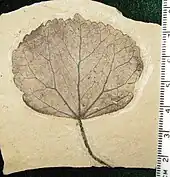
Fossilized leaf found in Republic from the Eocene katsura species Cercidiphyllum obtritum

Fossilized leaf found in Republic from the Eocene sweetfern species Comptonia columbiana
- Caesalpinia
- †Calkinsia - type locality of genus[8]
- †Calycites
- †Calycites ardtunensis[47]
- Calycocarpum
- Undescribed Ypresian Klondike Mountain Formation fossil(s)[48]
- Camellia[8]
- †Camellia multiforma[8]
- Carex
- Undescribed Late Pleistocene Manis Mastodon site subfossil[1]
- Carpinus
- Carya[9]
- †Carya cashmanensis – type locality for species[8]
- †Carya pugetensis - type locality for species[8]
- †Carya washingtonensis - type locality for species[50]
- Undescribed Ypresian Klondike Mountain Formation fossil(s)[22][17]
- Castanea
- †Castanea orientalis[39]
- †Castaneophyllum
- Undescribed Ypresian Klondike Mountain Formation fossil(s)[17]
- Castanopsis
- †Castanopsis franklinensis – type locality for species[8]
- †Cedrelospermum
- Undescribed Ypresian Klondike Mountain Formation fossil(s)[48]
- Celastrus
- †Celastrus spokanensis[39]
- Ceratophyllum
- Cercidiphyllum
- Chenopodium
- Undescribed Late Pleistocene Manis Mastodon site subfossil(s)[1]
- Cladrastis
- †Cladrastis pugetensis – type locality for species[8]
- Clematis
- Undescribed Ypresian Klondike Mountain Formation fossil(s)[44]
- Cocculus
- Cf. †Cocculus flabella
- Comptonia
- †Comptonia columbiana[43]
- †Comptonia hesperia[29]
- Cornus
- Cornus sericea (syn=Cornus stolonifera)[1]
- Undescribed Ypresian Klondike Mountain Formation fossil(s)[43][22][17]
- Corylopsis[51]
- †Corylopsis reedae - type locality for species[51]
- Corylus[49]
- Craigia
- Undescribed Ypresian Klondike Mountain Formation fossil(s)[47]
- Cf. Crataegus
- Undescribed Ypresian Klondike Mountain Formation fossil(s)[44]
- †Cruciptera
- †Cruciptera simsonii[52]
Plants D

Diospyros oregoniana
- Decodon
- Undescribed Ypresian Klondike Mountain Formation fossil[22]
- †Deviacer
- Undescribed Ypresian Klondike Mountain Formation fossil[47]
- †Dichrostachyoxylon
- †Dichrostachyoxylon occidentale - type locality for species[53]
- †Dillhoffia
- Dilodendron
- †Dilodendron boreale - type locality for species[14]
- Diospyros[38]
- †Diospyros oregoniana[32]
- †Diplodipelta
- †Diplodipelta miocenica
- Dipteronia
Plants E
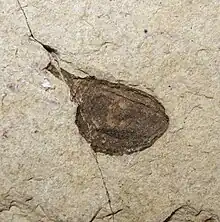
Eucommia montana fruit
- Eleocharis
- undescribed Late PLeistocene Manis Mastodon site subfossil
- Eucommia
- Euonymus
- †Euonymus pacificus - type locality for species[14]
- Exbucklandia
- Exbucklandia oregonensis[57]
Plants F
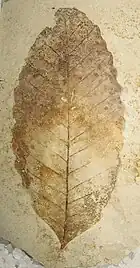

- †Fagopsis [43]
- †Fagopsis undulata[43]
- Fagus
- †Fagus langevinii[58]
- †Fagus manosii - type locality for species[26]
- †Fagus washoensis[9]
- †Florissantia
- Fothergilla
- †Fothergilla malloryi - type locality for species[51]
- †Fraxinus[9]
Plants G
- Galium
- Undescribed Late Pleistocene Manis Mastodon site subfossil[1]
- Gaultheria
- †Gaultheria pacifica - type locality for species[57]
- Gleditsioxylon
- Gordonia
- †Gordonia idahoensis[32]
- †Goweria - type locality of genus
Plants H

Hydrangea knowltoni
- Halesia
- †Halesia columbiana - type locality for species[57]
- †Hamamelidoxylon
- †Hamamelites
- Cf. †Hamamelites voyana
- Hesperomeles
- Tentatively identified undescribed Ypresian Klondike Mountain Formation fossil[60]
- Hibiscus
- Undescribed Ypresian Klondike Mountain Formation fossil[44]
- Hippuris
- Hydrangea[9]
- †Hydrangea bendirei - [9]
- †Hydrangea knowltoni - type locality for species[32]
- Undescribed Ypresian Klondike Mountain Formation fossil[44]
- Hypserpa[8]
Plants I
- Ilex
- †Ilex fulva[32]
- Cf. Ilex opaca
- Undescribed Ypresian Klondike Mountain Formation fossil[17][9]
- Itea
- Undescribed Ypresian Klondike Mountain Formation[43][17]
Plants J
- Juglans
- Undescribed Ypresian Klondike Mountain Formation fossil[22][17][9]
Plants K
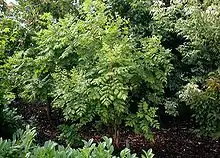
A living Koelreuteria tree
- Kadsura
- Undescribed Ypresian Klondike Mountain Formation fossil[12]
- Koelreuteria
- †Koelreuteria dilcheri[61]
Plants L
_Pigg_%2526_Wehr_2002_Plt2_fig22.png.webp)
- †Langeranthus - type locality for genus
- †Langeranthus dillhoffiorum - type locality for species[62]
- †Langeria – type locality for genus
- †Langeria magnifica – type locality for species[43]
- †Laurophyllum
- †Leguminosites
- †Leguminosites bonseri[39]
- Lemna
- Undescribed Late Pleistocene Manis Mastodon site subfossil[1]
- Cf. Leucothoe
- Undescribed Ypresian Klondike Mountain Formation fossil[44]
- Liquidambar
- †Liquidambar changii[63]
- †Liquidambar pachyphyllum[32]
- Cf. †Liquidambar hisauchii[26]
- †Litseaphyllum
- Undescribed Ypresian Klondike Mountain Formation fossil[12]
- Liriodendron
- †Liriodendron hesperia – type locality for species[64]
- †Litseaphyllum
- Undescribed Ypresian Klondike Mountain Formation fossil[12]
- Lysichiton?
- †"Lysichiton washingtonense" – type locality for species[36]
Plants M
- Macaranga
- †Macclintockia
- †Macclintockia pugetensis – type locality for species[8]
- †Macginicarpa
- Undescribed Ypresian Klondike Mountain Formation fossil[47]
- †Macginitiea
- Cf. †Macginitea angustilobia[65]
- †Macginitiea gracilis[43]
- Machilus
- Magnolia
- †Magnolia dayana[14]
- †Magnolia latahensis - type locality of species[14]
- Undescribed Early Miocene Douglas Canyon Formation fossil[39]
- Undescribed Ypresian Klondike Mountain Formation fossil[44]
- Malus
- Undescribed Ypresian Klondike Mountain Formation fossil[17]
- Meliosma
- Undescribed Ypresian Klondike Mountain Formation fossil[48]
- †Menispermites
- Cf. †Menispermites parvareolatus
- Mentzelia
- †Mentzelia occidentalis - type locality for species[14]
- Menyanthes
- Undescribed Late Pleistocene Manis Mastodon site subfossil[1]
- Morus
- Undescribed Ypresian Klondike Mountain Formation fossil[44]
- Myriophyllum
Plants N
- Neviusia
- Undescribed Ypresian Klondike Mountain Formation fossil[44]
- †Nordenskioldia
- †Nordenskioldia interglacialis[66]
- Undescribed Ypresian Klondike Mountain Formation fossil[47]
- Nuphar
- Nyssa[9]
Plants O
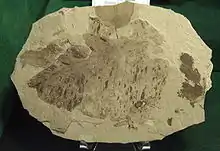
Fossilized leaf found in Ferry County belonging to the Eocene golden-club Orontium wolfei
- Ocotea
- Undescribed Ypresian Klondike Mountain Formation fossil[12]
- Oemleria
- †Oemleria janhartfordae - type locality for species[69]
- Orontium
- †Orontium wolfei - type locality for species[70]
- Ostrya
- †Ostrya oregoniana[14]
Plants P
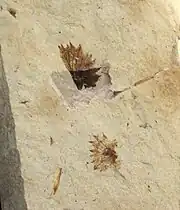
Palaeocarpinus barksdaleae samaras
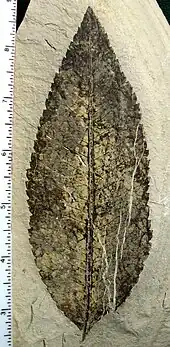
Photinia pagae leaf
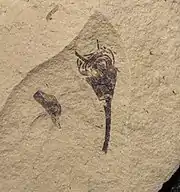
Prunus cathybrownae flower
- †Palaeocarpinus
- †Palaeocarpinus barksdaleae[49]
- Undescribed Ypresian Klondike Mountain Formation fossils[49]
- †Palaeophytocrene
- Undescribed Ypresian Klondike Mountain Formation fossils[47]
- †Paleoallium - type locality for genus
- †Paleoallium billgenseli - type locality for species[71]
- Paliurus
- †Paraconcavistylon - type locality for genus
- †Paraconcavistylon wehrii - type locality for species[74]
- Paulownia[9]
- †Paulownia columbiana - type locality for species[9]
- Pedicularis
- Undescribed Late Pleistocene Manis Mastodon site subfossil[1]
- †Pentacentron Manchester et al., 2018[75]
- †Pentacentron sternhartae Manchester et al., 2018 - type locality for species[75]
- Persea
- Philadelphus
- ↑Philadelphus pardeei - type locality for species[14]
- Undescribed Ypresian Klondike Mountain Formation fossils[44]
- †Phoebe
- Undescribed Ypresian Klondike Mountain Formation fossils[43]
- †Photinia
- †Photinia pageae – type locality for species[43]
- Aff. Physocarpus
- Undescribed Ypresian Klondike Mountain Formation fossils - tentative record[22]
- Phytocrene
- Cf. †Phytocrene acutissima
- †Plafkeria - type locality for genus[8][11]
- †Plafkeria rentonensis - type locality for species[8]
- Undescribed Ypresian Klondike Mountain Formation fossils[47]
- Plantago
- Undescribed Late Pleistocene Manis Mastodon site subfossil[1]
- †Platananthus
- Undescribed Ypresian Klondike Mountain Formation fossils[76]
- Platanus
- †Platimeliphyllum
- Platycarya
- Cf. †Platycarya pseudobrauni
- Platyopuntia
- Undescribed Late Pleistocene Manis Mastodon site subfossil[1]
- Polygonum
- Polypodium
- †Polytrichites -Type locality for genus[5]
- †Polytrichites spokanensis - Type locality for species[5]
- Populus
- Porana
- †Porana microcalyx - Type locality for species[29]
- Potamogeton[9]
- Potentilla
- Prunus
- †Pseudosalix
- Undescribed Ypresian 'Klondike Mountain Formation fossils[22]
- Ptelea
- †Ptelea miocenica - type locality for species[68]
- Pterocarya[9]
- †Pterocarya mixta - type locality for species[14]
- †Pterocarya pugetensis – type locality for species[8]
- Undescribed Ypresian Klondike Mountain Formation fossils[47]
- Pteroceltis
- Undescribed Ypresian Klondike Mountain Formation fossil[76]
- †Pteroheterochrosperma
- †Pteroheterochrosperma horseflyensis[80]
- †Pteronepelys
- †Pugetia - type locality for genus[8]
- †Pugetia longifolia – type locality for species[8]
- Pyracantha
- Undescribed Ypresian Klondike Mountain Formation fossils - tentative record[60]
- Cf. Pyrus
- Undescribed Ypresian Klondike Mountain Formation fossils - tentative record[60]
Plants Q

†Quercus hiholensis acorn in matrix
- Quercus[9]
- †Quercus axelrodi – type locality for species[57]
- †Quercus bretzi[14]
- †Quercus cognatus[39]
- †Quercus dayana[32]
- †Quercus hiholensis – type locality for species[82]
- †Quercus leuca (syn Quercus sahnii[41][26])- type locality for species[38]
- †Quercus mccanni – type locality for species[68]
- †Quercus payettensis[32]
- †Quercus pseudolyrata[68]
- †Quercus simulata[39][14]
- Undescribed Ypresian Klondike Mountain Formation fossil[47][22]
- Undescribed Miocene Latah Formation cupule fossils[5]
Plants R

Eocene Republica hickeyi leaf found in Republic Washington

Fossilized compound leaf from an Eocene sumac Rhus hybrid
- Ranunculus
- †Republica (plant) – type locality for genus[43]
- †Rhamnites [8]
- Rhododendron
- †Rhododendron knowltoni - type locality for species[29]
- Undescribed Ypresian Klondike Mountain Formation fossils[44][22][17]
- Rhus
- †Rhus boothillensis - type locality for species[83]
- †Rhus garwellii - type locality for species[83]
- †Rhus malloryi – type locality for species[43][83]
- †Rhus republicensis - type locality for species[83]
- Cf. †Rhus typhina
- †Rhysocaryoxylon[38][84]
- Ribes
- Undescribed Ypresian Klondike Mountain Formation fossils[44][22]
- Richteroxylon - type locality for genus[26]
- ↑Richteroxylon micropunctatum - type locality for species[26]
- Robinia
- †Robinia zirkelii[26]
- Cf. Rinorea
- Rosa
- Rubus
- Undescribed Ypresian Klondike Mountain Formation fossils[44]
- Rumohra
- †Rumohra bartonae - type locality for species[7]
Plants S
- †Sabalites[7]
 Fossilized fronds from Sabalites campbelli
Fossilized fronds from Sabalites campbelli - Sabia
- Undescribed Klondike Mountain Formation fossil[48]
- Salix[9]
- Cf. †Salix heartensis
- †Salix spokanensis - type locality for species[29]
- Undescribed Ypresian Klondike Mountain Formation fossil[22][17]
- Cf. Sapindus
- Sarcobatus
- Sassafras
- †Sassafras hesperia - type locality for species[43]
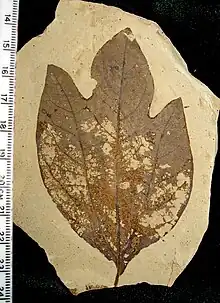 Fossilized leaf of the Eocene sassafras Sassafras hesperia
Fossilized leaf of the Eocene sassafras Sassafras hesperia
- †Schoepfia
- †Schoepfia republicensis - type locality for species[43]
- Scirpus
- Undescribed Late Pleistocene Manis Mastodon site subfossil
- †Shirleya[85]
 Miocene Shirleya grahamae fruit
Miocene Shirleya grahamae fruit - Sloanea
- Undescribed Klondike Mountain Formation fossil[76]
- Smilax
- †Smilax magna[29][9]
- Undescribed Klondike Mountain Formation fossil[12]
- Sophora
- †Sophora spokanensis - type locality for species[5]
- Aff. Sorbus
- Undescribed Klondike Mountain Formation fossil[22][17]
- Sparganium
- Spiraea
- Undescribed Klondike Mountain Formation fossil[22]
Plants T
- †Ternstroemites
- †Ternstroemites ravenensis – type locality for species[8]
- Undescribed Ypresian Klondike Mountain Formation fossil "Species A"[43]
- Undescribed Ypresian Klondike Mountain Formation fossil "Species B"[43]
- Tetracentron
- †Tetracentron hopkinsii Pigg et al., 2007[75]
- †Tetrapleuroxylon
- †Thalictrum
- Undescribed Late Pleistocene Manis Mastodon site subfossil[1]
- Tilia
- †Tilia johnsoni – type locality for species[43]
- Trochodendron
- Tsuga[9]
- Tsuga heterophylla - subfossil[1]
- †Tsuga latahensis – type locality for species[29]
- Tsuga mertensiana - subfossil[1]
- Undescribed Ypresian Klondike Mountain Formation fossil[24]
- †Tsukada – type locality for genus
- †Tsukada davidiifolia – type locality for species[43]
- Typha
- Typha latifolia[1]
- Undescribed Ypresian Klondike Mountain Formation fossil[12]
Plants U

Ulmus chuchuanus, Ypresian Klondike Mountain Formation
- Ulmus[9]
- Utricularia
- Undescribed Late Pleistocene Manis Mastodon site subfossil[1]
Plants V
- Viburnum[8]
- †Viburnum pugetensis – type locality for species[8]
- †Vinea - type locality for genus[8]
- †Vinea pugetensis – type locality of species[8]
- Vitis
- Undescribed Eocene Puget Group fossil
- Undescribed Ypresian Klondike Mountain Formation fossil[44][47]
Plants W
- †Wessiea[89]
- Woodwardia[9][89]
- †Woodwardia aurora - type locality for species[7]
- †Woodwardia clarus - type locality for species[7]
- Woodwardia virginica[89]
Plants Z
- Zannichellia
- Zelkova
- Undescribed Eocene Puget Group fossil
- †Zingiberopsis
- Cf. †Zingiberopsis isonervosa
- †Zizyphoides
- Undescribed Ypresian Klondike Mountain Formation fossils[22]
Poriferans
- Aphrocallistes
- Cf. †Aphrocallistes polytretos
- Eurete
- †Eurete? goederti
- Farrea
- Tentatively reported undescribed Oligocene Lincoln Creek Formation fossil
- Hexactinella
- †Hexactinella conica – type locality for species
- †Hexactinella tubula – type locality for species
- Hyperbaena[8]
- †Hyperbaena dilleri[8]
Annelids
- †Helminthopsis
- Cf. Protula
- undescribed middle Eocene Puget Group Tukwila Formation fossil(s)[91]
- †Rotularia
- †Rotularia tejonense
- Osedax
- undescribed Rupelian Makah Formation fossil(s)[92]
- undescribed Rupelian-Chattian Pysht Formation fossil(s)[92]
- undescribed Chattian Lincoln Creek Formation fossil(s)[93]
- †Skolithos
- Indeterminate Chuckanut Formation Skolithos type burrows[90]
Nematoids
Cnidarians
Cnidarians A-C
- Astrangia
- †Astrangia clarki – type locality for species
- Astreopora
- †Astreopora duwamishensis – type locality for species
- †Astreopora sanjuanensis – type locality for species
- Balanophyllia
- †Balanophyllia blakelyensis
- †Balanophyllia cowlitzensis – type locality for species
- †Balanophyllia fulleri – type locality for species
- †Balanophyllia teglandae – type locality for species
- †Balanophyllia variabilis
- †Balanophyllia washingtonensis – type locality for species[91]
- Caryophyllia
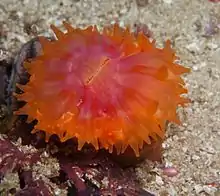 A living Caryophyllia solitary coral
A living Caryophyllia solitary coral- †Caryophyllia blakeleyensis – type locality for species
- †Caryophyllia woodmanensis – type locality for species
- †Caryophyllia wynoocheensis – type locality for species
- Coenocyathus
- †Coenocyathus hannibali – type locality for species
- Colpophyllia
- †Colpophyllia reagani – type locality for species
Cnidarians D-I
- Deltocyathus
- †Deltocyathus insperatus – type locality for species
- Dendrophyllia
 A living Dendrophyllia cup coral
A living Dendrophyllia cup coral- †Dendrophyllia cowlitzensis – type locality for species
- †Dendrophyllia hannibali – type locality for species
- †Dendrophyllia tejonensis
- †Dimorphastrea
- †Dimorphastrea vaughani – type locality for species
- †Discotrochus
- Undescribed Eocene Puget Group Tukwila Formation fossil(s)[91]
- Eusmilia
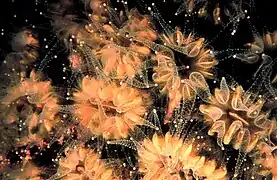 A living Eusmilia stony coral
A living Eusmilia stony coral- †Eusmilia bainbridgensis – type locality for species
- Flabellum
- †Flabellum californicum
- †Flabellum clarki
- †Flabellum hertleini – type locality for species
- "Graphularia"
- Aff. Graphularia sasai[94]
- Indeterminate Late Eocene to Oligocene Pysht & Lincoln Creek Formation fossils[94]
- Isidella
- Indeterminate late Oligocene Pysht Formation fossils[94]
Cnidarians L-R
- Lepidisis
- Indeterminate late Oligocene Pysht Formation fossils[94]
- Leptastrea
- †Leptastrea hertleini
- Madracis
- †Madracis crescentensis – type locality for species
- †Madracis stewarti – type locality for species
- Montipora
- †Montipora schencki – type locality for species
- Paracyathus
- Petrophyllia
- †Petrophyllia clarki
- †Petrophyllia weaveri – type locality for species
- Radicipes?
- Indeterminate late Oligocene Lincoln Creek Formation fossils[94]
Cnidarians S-Z
- Sclerhelia ? – tentative report
- Siderastrea
- Cf. †Siderastrea vancouverensis
- †Siderastrea washingtonensis – type locality for species
- Stephanocyathus
- †Stephanocyathus holcombensis – type locality for species
- Stylaster
- †Stylaster milleri – type locality for species
- Trochocyathus
- †Trochocyathus crooki
- †Trochocyathus nomlandi
- †Trochocyathus townsendensis – type locality for species
- Tubastraea
- †Tubastraea nomlandi – type locality for species
- Turbinolia
- †Turbinolia dickersoni
- †Turbinolia quaylei – type locality for species
- †Turbinolia weaveri – type locality for species[91]
Echinoderms
- Brisaster
- undescribed middle Eocene Puget Group Tukwila Formation fossil(s)[91]
- Eupatagus
- Cf. †Eupatagus carolinensis
- Isocrinus
- Tentatively reported undescribed early Oligocene Pysht Formation fossil
- Schizaster
Brachiopods
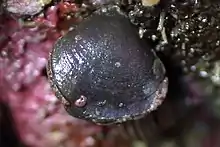
Hemithiris psittacea
living specimen
living specimen
- Craniscus
- †Craniscus edwilsoni – type locality for species
- Gryphus
- Undescribed Ypresian Crescent Formation fossil
- Hemithiris
- †Hemithiris reagani
- Terebratulina
- †Terebratulina unguicula
- †Terebratulina washingtonensis (syn=Rhynchonella washingtoniana)[91]
- †Terebratulina weaveri
Molluscs
Molluscs A
- Acharax
- †Acharax dalli (Clark, 1925) (syn = Solemya dalli)[95]
- Acila
- †Acila conradi
- †Acila decisa
- †Acila gettysburgensis
- †Acila pugetensis
- Acrilla
- †Acrilla (Ferminoscala) aragoensis[91]
- †Acutostrea
- †Acutostrea idriaensis[91]
- Aforia
- †Aforia clallamensis
- Amaea
- †Amaea olympicensis
- †Amaea washingtonensis
- Amauropsis
- †Amauropsis blakeleyensis
- Anadara
- †Anadara devincta
- Cf. †Anadara lakei
- †Anamirta
- Cf. †Anamirta milleri – or unidentified comparable form
- Ancistrolepis
 Fossilized shell of the whelk sea snail Ancistrolepis
Fossilized shell of the whelk sea snail Ancistrolepis- †Ancistrolepis rearensis
- †'Anechinocardium
- †Anechinocardium lorenzanum
- Cf. †Anechinocardium weaveri
- †Aperiploma
- †Aperiploma bainbridgensis
- †Archarax
- †Archarax dalli
- Architectonica
- Cf. †Architectonica congnata
- Argobuccinum
 Shell of an Argobuccinum triton sea snail
Shell of an Argobuccinum triton sea snail- †Argobuccinum goodspeedi
- †Argobuccinum mathewsonii
- †Argobuccinum washingtoniana
- †Aturia
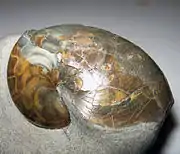
- Cf. †Aturia alabamensis – or unidentified comparable form
- †Aturia angustata
- †Aturia grandior – type locality for species
Molluscs B
- Barbatia
- †Barbatia landesi
- Bathybembix
- †Bathybembix columbiana
- Batissa
- †Batissa dubia
- †Batissa newberryi
- Bonellitia
- †Bonellitia paucivaricata
- Brachidontes
- †Brachidontes (Brachidontes) cowlitzensis (syn=Modiolus cowlitzensis)[91]
- †Brachidontes dichotomus
- †Bruclarkia
- †Bruclarkia oregonensis
- †Bruclarkia thor
- †Bruclarkia yaquinana
- Buccinum
- †Buccinum percrassum
Molluscs C
- Cadulus
- †Cadulus gabbi
- Calliostoma
- †Calliostoma mea
- Callithaca
- †Callithaca tenerrima
- †Calorebama
- †Calorebama inornata[91]
- Calyptraea
- †Calyptraea diegoana[91]
- †Calyptraea washingtonensis
- Cancellaria
- Cantharus
- †Cantharus cowlitzensis[91]
- Cardiomya ? – tentative report
- Cerithiopsis
- †Cerithiopsis vaderensis
- †Cerithiopsis washingtoniana
- Chama
- Chione
- †Chione ensifera
- †Chione securis
- Chlamys
- †Chlamys hastata
- †Chlamys islandica
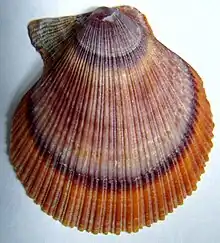 A modern shell of Chlamys islandica, or Iceland scallop
A modern shell of Chlamys islandica, or Iceland scallop - †Chlamys waylandi
- †Chrysodomus
- †Chrysodomus imperialis
- Cidarina
- †Cidarina antiquua – type locality for species
- †Cimomia
- †Cimomia hesperia – type locality for species
- Cirsotrema
- †Cirsotrema saundersi
- Clavus
- †Clavus fryei[91]
- Clinocardium
- †Clinocardium meekianum
- †Clinocardium nuttallii
- Colus
- †Colus sekiuensis - type locality for species[96]
- †Colwellia
- †Conchocele
- †Conchocele bisecta
- Conus
- Corbicula
- †Corbicula cowlitzensis
- Cf. †Corbicula willisi
- Corbula
- †Corbula dickersoni[91]
- †Corbula parilis
- Costacallista
- †Costacallista conradiana (syn=Microcallista conradiana)[91]
- †Cowlitzia
- †Cowlitzia washingtonensis
- Craspedochiton
- †Craspedochiton eernissei
- Crassatella
- †Crassatella uvasana
- †Crassatella wasana
- †Crassatella washingtoniana (syn=Crassatellites washingtoniana)[91]
- Crenella – tentative report
- Crepidula
- †Crepidula praerupta
- †Crepidula princeps
- †Crepidula rostralis
- †Crepidula ungana
- †Cristispira
- †Cristispira pugetensis
- †Cryptochorda
- †Cryptochorda californica
- †Cryptolucina
- †Cryptolucina megadyseides
- Cryptomya
- †Cryptomya californica
- Cryptonatica
- Cyclammina
- †Cylichnina
- †Cylichnina tantilla[91]
- Cyclocardia
- †Cyclocardia hannibali
- †Cyclocardia subtenta
- Cyclostremella
- Cymatium
- Cypraea
- †Cypraeogemmula
- †Cypraeogemmula warnerae
Molluscs D
- Delectopecten
- Undescribed Oligocene Lincoln Creek Formation fossil
- undescribed Eocene "Unit B" Cowlitz Formation fossil
- Dentalium
- †Dentalium porterensis
- †Dentalium pseudonyma
- †Dentalium schencki
- †Dentalium stramineum
- †Dentimitra
- †Dentimitra cretacea
- Diodora
- †Diodora stillwaterensis (syn=Fissuridea stillwaterensis)
- Dosinia
- †Dosinia whitleyi
Molluscs E
- Echinophoria
- †Echinophoria dalli
- †Echinophoria trituberculata (syn=Galeodea trituberculata)[91]
- †Ectinochilus
- Emarginula
- †Emarginula dotyhillsensis – type locality for species
- †Eopustularia
- †Eopustularia goedertorum – type locality for species
- Epitonium
- †Eratotrivia
- †Eratotrivia crescentensis
- Erginus
- †Erginus vaderensis
- Eulima
- †Eulima clarki
- †Eulima lewisiana[91]
- Eurytellina
- †Eurytellina lorenzoensis
- Euspira
- †Eutrephoceras
- †Eutrephoceras eyerdami – type locality for species
- Exilia
- †Exilia clarki
- †Exilia dickersoni[91]
- †Exilia mclellani
Molluscs F

A living Fusinus sea snail
- Falsifusus
- †Falsifusus marysvillensis
- †Ficopsis
- Ficus
- †Ficus clallamensis
- †Ficus modesta
- †Ficus restorationensis
- †Ficus washingtonensis[39]
- Fulgoraria
- †Fulgoraria indurata
- †Fulgoraria weaveri
- Fulgurofusus
- †Fulgurofusus washingtoniana[91]
- Fusinus
- †Fusinus dilleri
- †Fusinus willisi[91]
Molluscs G
- Galeodea
 Shell of a Galeodea helmet snail
Shell of a Galeodea helmet snail- †Galeodea apta
- †Galeodea crescentensis
- †Galeodea fax
- †Galeodea petrosa
- †Galeodea rex
- Gari
- Gemmula
- †Gemmula abacta
- †Gemmula barksdalei
- †Gemmula borgenae
- †Gemmula fasteni[91]
- †Gemmula pluchra
- †Gemmula pulchra
- Glycymeris
- †Glycymeris fresnoensis
- †Glycymeris sagittata[91]
- †Glycymeris wishkahensis
- Gyrineum
- †Gyrineum marshalli
Molluscs H
- Haplocochlias
- †Haplocochlias montis
- Hiatella
- Hipponix
- †Hipponix amoldi
- Homalopoma
- †Homalopoma hieroglyphica
- †Homalopoma umpquaensis
- †Humptulipsia - type locality for genus
- †Humptulipsia raui - type locality for species[97]
Molluscs I
- Idas
- Idas olympicus - type locality of species[96]
- Ischnochiton
- †Ischnochiton goederti
- Isognomon
- †Isognomon (Isognomon) clarki
Molluscs K
Molluscs L
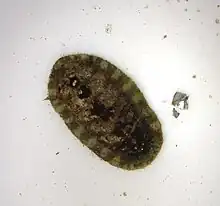
A living Lepidochitona chiton
- Lamelliconcha
- †Lamelliconcha eocenica
- Laevidentalium
- undescribed middle Eocene Puget Group Tukwila Formation fossil(s)[91]
- Lepidochitona
- †Lepidochitona lioplax
- †Lepidochitona squiresi
- †Lepidochitona washingtonensis
- Lepidopleurus
- †Lepidopleurus propecajetanus
- Leptochiton
- †Leptochiton alveolus
- †Leptogyra
- ††Leptogyra squiresi – type locality for species[96]
- Leukoma
- Liotia
- †Liotia washingtoniana – type locality for species
- †Litorhadia
- †Litorhadia washingtonensis (syn=Leda washingtonensis, Nuculana washingtonensis)[91]
- Lucinoma
- †Lucinoma acutilineata
- †Lucinoma annulatum
- Cf. †Lucinoma columbiana
- †Lucinoma hannibali
- Lyria
- †Lyria andersoni
Molluscs M
- Macoma
- †Macoma albaria
- †Macoma astori
- †Macoma calcarea
- †Macoma inquinata
- Macoma nasuta
- Cf. †Macoma secta
- †Macoma snohomishensis
- †Macoma sookensis
- †Macoma twinensis
- Macrocallista
- †Macrocallista cathcartensis
- Mactromeris
- †Mactromeris albaria
- †Mactromeris pittsburgensis
- Marcia
- †Marcia oregonensis
- Margarites
- †Margarites (Margarites) chappelli
- †Margarites (Margarites) serceus
- †Margarites (Pupillaria) columbiana
- Marginella
- †Marginella shepardae
- †Megistostoma
- †Megistostoma gabbiana
- Mitra
- †Mitra washingtoniana
 Fossilized shell found in Vader; the hypotype specimen of the Eocene miter snail Mitra washingtoniana
Fossilized shell found in Vader; the hypotype specimen of the Eocene miter snail Mitra washingtoniana
- Modiolus
- Cf. †Modiolus restorationensis
- †Modiolus willapaensis
- †Molopophorus
- Cf. †Molopophorus newcombei
- Murex
- †Murex cowlitzensis
- †Murex sopenahensis[91]
- †Mya
- Mytilus
- †Mytilus dichotomus[91]
- Mytilus edulis
- †Mytilus sammamishensis
- †Mytilus snohomishensis
- †Mytilus stillaguamishensis
- Cf. †Mytilus tichanovitchi
Molluscs N
- Nassa
- †Nassa eocenica (syn=Latirus eocenica)[91]
- Nassarius
- †Nassarius mednica
- Natica
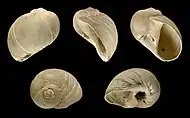 Multiple views of a fossilized shell belonging to a Natica moon snail
Multiple views of a fossilized shell belonging to a Natica moon snail- Cf. †Natica clarki
- †Natica oligocenica
- †Natica teglandae
- †Natica vokesi
- †Natica weaveri
- †Nayadina
- †Nayadina batequensis
- †Nekewis
- †Nekewis washingtoniana[91]
- Nemocardium
- †Nemocardium lincolnensis
- †Nemocardium linteum
- Neptunea
- †Neptunea landesi
- †Neptunea lincolnensis
- †Neptunea teglandae
- Nerita
- †Nerita triangulata
- Neverita
- †Neverita globosa
- †Neverita jamesae
- †Neverita reclusiana
- †Nitidavenus
- Cf. †Nitidavenus conradi
- Nucella
- †Nucella decemcostata
- Nucella lamellosa
 Shell of a Nucella lamellosa murex snail
Shell of a Nucella lamellosa murex snail
- †Nucleolaria
- †Nucleolaria cowlitziana – type locality for species
- Nucula
- †Nucula hannibali
- Nuculana
Molluscs O

Five modern Ostrea lurida, or Olympic oysters
Molluscs P
- †Pachycrommium
- †Pachycrommium clarki
- †Pachycrommium hendoni[91]
- Pandora
- †Pandora vanwinkleae
- †Pandora washingtonensis
- Panopea
- †Panopea abrupta
- †Panopea ramonensis
- Parvamussium
- †Parvamussium stanfordense
- Patelloida
- †Patelloida tejonensis
- †Patelloida vancouverensis[91]
- Patinopecten
- †Patinopecten dilleri
- Pecten
- †Pecten clallamensis
- †Perse? – tentative report
- Persicula
- Pitar
- Plagiocardium
- †Plagiocardium breweri
- Pleurofusia
- †Pleurofusia cowlitzensis (syn=Turricula cowlitzensis)[91]
- Polinices
- †Polinices gesteri
- †Polinices hornii[91]
- †Polinices lewisii
- †Polinices rectus
- †Polinices victorianus
- †Polinices washingtonensis
- Poromya
- †Poromya teglandae
- Portlandia
- †Portlandia chehalisensis[98] - type locality for the species (synonym=Yoldia chehalisensis)
- †Portlandia packardi
- †Potamides
- †Potamides lewisiana
- †Potamides packardi
- †Priscofusus
- †Priscofusus chehalisensis
- Cf. †Priscofusus geniculus
- †Priscofusus goweri
- †Priscofusus sanctaecrucis
- †Priscofusus slipensis
- †Priscofusus stewarti
- †Provanna
- †Provanna antiqua
- Psammacoma
- †Psammacoma arctata
- Pseudocardium
- †Pseudocardium packardi (syn=Spisula packardi)[91]
- Pseudoliva
- †Pseudoliva lineata
- Pteria
- †Pteria clarki
- Cf. †Pteria pellucida
- Purpura
- †Purpura lurida
- Pyramidella
- †Pyramidella vaderensis
Molluscs R
- Rectiplanes? – tentative report
- Retusa
- †Retusa tantilla
- Rimella
- †Rimella elongata
Molluscs S
- Saxidomus
- Scalina
- †Scalina lincolnensis
- Scaphander
- †Scaphander (Mirascapha) costata[91]
- †Scaphander washingtonensis
- †Schedocardia
- Semicassis
- †Semicassis pyshtensis
- Septifer
- †Septifer dichotomus
- Serripes
- Sinum
- Siphonalia
 Shell of the whelk sea snail Siphonalia
Shell of the whelk sea snail Siphonalia- †Siphonalia bicarinata
- †Siphonalia sopenahensis[91]
- Solamen
- †Solamen snavelyi
- Solariella
- †Solariella (Solariella) olequahensis
- †Solariella cicca
- †Solariella garrardensis
- †Solariella kincaidi
- Solen
- †Solen columbianus[91]
- †Solen sicarius
- Solena
- †Solena clarki
- †Solena columbina
- †Solena conradi
- Cf. †Solena parallelus
- †Spirocrypta
- †Spirocrypta pileum[91]
- Spirotropis
- †Spirotropis kincaidi
- Spisula
.JPG.webp) Shell of a Spisula, or surf clam
Shell of a Spisula, or surf clam- Cf. †Spisula hannibali
- †Spisula sookensis
- †Spisula twinensis
- Spondylus
- †Spondylus carlosensis
- Stenoplax
- †Stenoplax quimperensis
- †Sulcobuccinum
- †Sulcobuccinum dilleri
- †Sulcocypraea
- †Sulcocypraea mathewsonii
- Surculites
- †Surculites mathewsoni
- †Surculites wynoocheensis? – tentative report
- Sveltella
- †Sveltella keaseyensis? – tentative report
Molluscs T
- †Tejonia
- †Tejonia moragai[91]
- Tellina
- †Tellina cowlitzensis[91]
- †Tellina emacerata
- †Tellina soledadensis
- Tenagodus
- †Tenagodus bajaensis
- Teredo
- Undescribed Cowlitz and Crescent Formation fossils
- Thais
- †Thais lamellosa
- Thracia
- †Thracia dilleri
- †Thracia schencki
- †Thracia trapezoides
- Thyasira
- †Thyasira folgeri
- †Thyasira hannibali
- †Thyasira peruviana? – tentative report
- †Thyasira xylodia - type locality for species[96]
- Tivela
- †Tivela (Pachydesma) aragoensis[91]
- †Tivelina
- †Tivelina vaderensis - type locality for species[91]
- Tresus
- Trochita
- Unidentified Oligocene Clallam Formation fossils
- Tudicla
- †Tudicla blakei
- †Tudicla trophonoides
- Turcica
- Turricula
- †Turricula ornata
- †Turricula washingtonensis[91]
- Turris
- †Turris perversa
- †Turris pulchra (syn=Hemipleurotoma pulchra)[91]
- Turritella
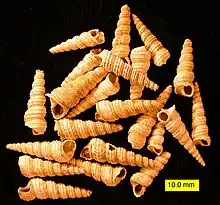 Fossilized shells of the Late Jurassic-modern tower snail Turritella
Fossilized shells of the Late Jurassic-modern tower snail Turritella
Molluscs U
- Urosalpinx
- †Urosalpinx hannibali
Molluscs V
- Venericardia
- †Vertipecten
- †Vertipecten fucanus
- Vesicomya
- †Vesicomya chinookensis
- Volsella (mollusc)
- †Volsella restorationensis
- †Volsella trinominata
Molluscs W
Molluscs X
- Xenoturris
- †Xenoturris antiselli[100]
- †Xylodiscula
Molluscs Y
- Yoldia
- †Yoldia astoriana[101]
- †Yoldia blakeleyensis - type locality for species[101]
- †Yoldia clallamensis – type locality for species
- †Yoldia duprei - type locality for species[102]
- †Yoldia newcombi[98]
- †Yoldia olympiana[98]
- †Yoldia reagani[98]
- †Yoldia sammamishensis - type locality for the species[98]
- †Yoldia temblorensis[101]
- Cf. †Yoldia supramontereyensis - related form[100]
Arthropods
Arthropods A
- Acidota
- Aclypea
- Acrulia
- †Acrulia tumidula
- Actium
- Undescribed Klaloch site subfossil(s)[103]
- †Adamsochrysa
- †Adamsochrysa wilsoni – type locality for species[104]
- Aegialia
 Illustration of an Aegialia dung beetle
Illustration of an Aegialia dung beetle- Aegialia cylindrica
- Aegialia lacustris
- Agabus
- Undescribed Olympia beds Formation subfossil(s)[105]
- Agathidium
- Undescribed Klaloch site subfossil(s)[103]
- Agonum
- †Ainigmapsychops – type locality for genus
 Fossilized wing and holotype specimen of the Eocene lacewing Ainigmapsychops
Fossilized wing and holotype specimen of the Eocene lacewing Ainigmapsychops- †Ainigmapsychops inexspectatus – type locality for species[106]
- †Allorapisma – type locality for genus
 Fossilized wing found in Republic; the holotype specimen of the Eocene lacewing Allorapisma
Fossilized wing found in Republic; the holotype specimen of the Eocene lacewing Allorapisma- †Allorapisma chuorum – type locality for species[107]
- Alniphagus
- Altica
- Cf. †Altica lazulina
- Amara
- Cf. Amara conflata
- Anthrax
- †Anthrax dentoni – type locality for species[108]
- †Antiquiala
- †Antiquiala snyderae[109]
- Aphodius
- Undescribed Klaloch site subfossil(s)[103]
- Apion
- Undescribed Klaloch site subfossil(s)[103]
- †Aporolepas
- undescribed Ypresian-Bartionian Crescent Formation fossil(s)
- Aphrophora
- undescribed Ypresian Klondike Mountain Formation fossil(s)[110]
- Arcoscalpellum
- †Arcoscalpellum knapptonensis – type locality for species
- †Arcoscalpellum raricostatum
- Arpedium
- Arpedium cribratum
- Artochia
- †Artochia productifrons[103]
- Asiorestia
- Asiorestia pallida[103]
- Atomaria
- Undescribed Olympia beds Formation subfossil(s)[105]
- Auleutes
Arthropods B
- Balanus
- Balanus crenatus
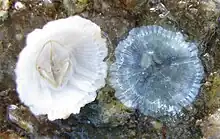 Shell (left, internal view) and calcified basis (right) of a modern Balanus crenatus acorn barnacle
Shell (left, internal view) and calcified basis (right) of a modern Balanus crenatus acorn barnacle
- Bembidion
 A living Bembidion ground beetle
A living Bembidion ground beetle - Bibio
- Undescribed Miocene Latah Formation fossil(s)
- Bledius
- †Bombus
- †Bombus proavus – type locality for species
- Byrrhus
- Undescribed Olympia beds Formation subfossil[105]
Arthropods C
- Calathus
- Caligodorus
- Caligodorus opacus
- Callianassa
- †Callianassa knapptonensis
- †Callianassa oregonensis
- †Callianassa twinensis
- Cf. †Callianassa porterensis
- undescribed Oligocene Makah Formation fossil
- undescribed Oligocene Pysht Formation fossil
- Callianopsis
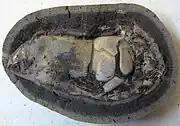 A fossilized pincer found in Clallam County belonging to the Oligocene mud shrimp Callianopsis clallamensis
A fossilized pincer found in Clallam County belonging to the Oligocene mud shrimp Callianopsis clallamensis- †Callianopsis clallamensis - type locality for species[111]
- Calosoma
- †Calosoma fernquisti – type locality for species
- Cancer
- †Cancer bainbridgensis
- Carabus
- Catops
- Cercyon
- Chlaenius
- Cicindela
- †Cimbrophlebia
- †Cimbrophlebia brooksi – type locality for species
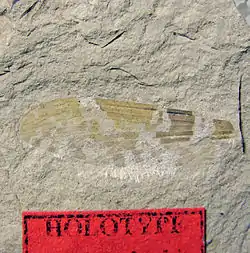 Fossilized wing found in Republic; the holotype specimen of the Eocene scorpionfly Cimbrophlebia brooksi
Fossilized wing found in Republic; the holotype specimen of the Eocene scorpionfly Cimbrophlebia brooksi - †Cimbrophlebia westae – type locality for species
- Cleptelmis
- †Cleptelmis ornata
- †Coeloma
- Coeloma martinezensis? - tentative report[91]
- Colymbetes
- Corixa
- Corticaria
- Cossonus
- Cryptophagus
- Curimopsis
- Cymbiodyta
- Cytilus
Arthropods D
- Dascillus
- †Dascillus latahensis – type locality for species
- Dendroctonus
- Dianous
- †Dianous nitidulus
- Diapterna
- †Dinokanaga[112]
- †Dinokanaga andersoni – type locality for species[112]
- †Dinokanaga dowsonae[112]
- †Dinokanaga sternbergi – type locality for species[112]
- †Dysagrion
- †Dysagrion pruettae - type locality for species[113]
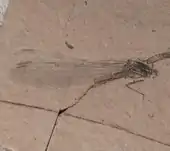
- †Dysagrionites
- †Dysagrionites delinei - type locality for species[113]
- Dyschirius (syn=Dyschiriodes)
- Dyschirius laevifasciatus
- Dyschirius montanus
- Undescribed Olympia beds Formation subfossil[105]
- Dytiscus
- †Dytiscus latahensis – type locality for species
Arthropods E
- Elaphrus
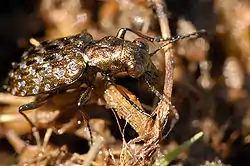 A living Elaphrus ground beetle
A living Elaphrus ground beetle - †Eoceneithycerus - type locality for genus
- †Eoceneithycerus carpenteri - type locality for species[114]
- †Eoprephasma – type locality for genus
- †Eoprephasma hichensi – type locality for species[115]
- †Eorpa
 Fossilized wing found in Republic; the holotype specimen of the Eocene scorpionfly Eorpa elverumi
Fossilized wing found in Republic; the holotype specimen of the Eocene scorpionfly Eorpa elverumi- †Eorpa elverumi – type locality for species
- †Eorpa ypsipeda? – tentative report
- †Eosphecium
- Undescribed Ypresian klondike Mountain Formation fossils[116]
- †Eourocerus - Type locality for genus
- †Eourocerus anguliterreus - type locality for species[117]
- Epophthalmia
- †Epophthalmia biordinata – type locality for species[108]
Arthropods F
- †Folindusia
- †Folindusia miocenica – type locality for species
- Foveoscapha
- Undescribed Klaloch site subfossils[103]
Arthropods G
- Galeruca
- Gastrophysa
- Geodromicus
- Undescribed Olympia beds Formation subfossils[105]
- Georissus
- Undescribed Olympia beds Formation subfossils[105]
- Gerris
- Undescribed Olympia beds Formation subfossils[105]
- †Glyphithyreus
- †Glyphithyreus weaveri
- Gymnusa
- Undescribed Klaloch site subfossils[103]
- Gyrinus
- Undescribed Olympia beds Formation subfossils[105]
Arthropods H
- Hapalaraea
- Undescribed Klaloch site subfossils[103]
- Helophorus
- Helophorus lacustris
- Cf. Helophorus oregonensis
- Hesperibalanus
- †Hesperibalanus cornwalli – type locality for species
- Cf. †Hesperibalanus sookensis
- Heterlimnius
- Heterosilpha
- Hydrobius
- Hydrothassa
- †Hydrothassa vittata
- Hygrotus
- Undescribed Olympia beds Formation subfossils[105]
- Hylurgops
- †Hylurgops rugipennis
- Hymenarcys
- †Hymenarcys cridlandi – type locality for species
Arthropods I
- †Idemlinea- Type locality for genus
- †Idemlinea versatilis - Type locality for species[109]
- Ilybius
- Ischnosoma
- Ischnosoma pictum
- Isochnus
- Isochnus rufipes
- †Ithyceroides – type locality for genus
- †Ithyceroides klondikensis – type locality for species[118]
Arthropods K
- Kalissus
- Kalissus nitidus
- †Klondikia – type locality for genus
- †Klondikia whiteae – type locality for species[119]
Arthropods L
- Laccobius
- Cf. Laccobius ellipticus
- Lanternarius
- Lanternarius parrotus
- Lapsus
- Lapsus tristis
- †Latahcoris – type locality for genus
- †Latahcoris spectatus – type locality for species
- Leiodes
- Undescribed Olympia beds Formation subfossil(s)[105]
- Lepidophorus
- Lepidophorus alternatus[103]
- †Leptostigma[120]
- Cf. Lepyrus
- Undescribed Olympia beds Formation subfossil.[105]
- Lioligus
- Lioon
- Liothorax
- Liothorax alternatus
- Lophomastix
- †Lophomastix altoonaensis
- †Lophomastix antiqua
- †Lophomastix boykoi
- †Lophomastix kellyi
- Loricera
Arthropods M


- Magdalis
- †Megaraphidia
- †Megaraphidia klondika - type locality for species[121]
- Megarthrus
- †Megokkos
- Melanoides
- †Melanoides fettkei
- †Metacarcinus
- †Metanephrocerus
- †Metanephrocerus belgardeae – type locality for species[124]
- Microedus
- Microlestes
- Micropeplus
- †Micropeplus cribratus
- †Micropeplus laticollis
- †Micropeplus nelsoni
- †Micropeplus punctatus
- †Miocordulia – type locality for genus
- †Miocordulia latipennis – type locality for species
- †Miopsyche – type locality for genus
- †Miopsyche alexanderi – type locality for species
- †Miopsyche martynovi – type locality for species
- Morychus
- Munida
- †Mursia
- †Mursia marcusana[111]
- Mycetoporus
- †Mycetoporus punctatissimus
- †Myrmeciites
- Unidentified Ypresian Klondike Mountain Formation fossils[126]
Arthropods N
- Nebria
- †Neoephemera
- †Neoephemera antiqua – type locality for species[127]
- Nitidotachinus
- Cf. †Nitidotachinus tachyporoides
- Notaris
- Notiophilus
- Nymphes
 Fossilized wing found in Ferry County; the holotype specimen of the Eocene lacewing Nymphes georgei
Fossilized wing found in Ferry County; the holotype specimen of the Eocene lacewing Nymphes georgei- †Nymphes georgei – type locality for species[128]
Arthropods O
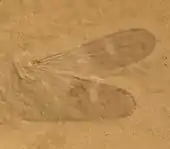
Okanagrion threadgillae
- Ochthebius
- †Ochthebius discretus
- Cf. †Ochthebius holmbergi
- Ocypus
- †Oecophylla
- †Oecophylla kraussei – type locality for species[129]
- †Okanagrion - type locality for genus
- †Okanopteryx
- †Okanopteryx jeppesenorum - type locality for species[113]
- Olophrum
- †Olophrum boreale
- †Olophrum consimile
- Opisthius
- †Opisthius richardsoni
- †Orbitoplax[130]
- Orchestes
- †Orchestes pallicornis
- †Oregonina[130]
- †Oregonina leucosiae[130]
- Cf. Oreodytes
- Orobanus
- Oropus
- †Osmylidia
- †Osmylidia glastrai - type locality for species [131]
- Oxytelus
- Oxytelus laqueatus
- Oxytelus niger
Arthropods P
- Paguristes
- †Paguristes hokoensis[132]
- †Palaeopsychops
- †Palaeopsychops marringerae – type locality for species[133]
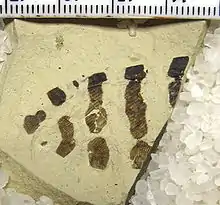 Eocene giant lacewing Palaeopsychops marringerae wing with color-patterning
Eocene giant lacewing Palaeopsychops marringerae wing with color-patterning - †Palaeopsychops timmi – type locality for species[133]
- †Palecphora
- Undescribed Ypresian Klondike Mountain Formation fossils[110]
- Pardalosus
- †Pardalosus pardalis
- Patrobus
- †Patrobus fossifrons
- †Patrobus stygicus
- Pelecomalium
- †Pelecomalium testaceum
- Pelenomus
- †Pelenomus squamosus
- Pelophila
- Periope
- †Periope ivesi – type locality for species
- †Petrolystra
- Undescribed Ypresian Klondike Mountain Formation fossils[110]
- Phaedon
- Phaedon armoraciae
.jpg.webp) A living Phaedon armoraciae leaf beetle
A living Phaedon armoraciae leaf beetle - †Phaedon oviforme
- †Phaedon prasinellus
- Phlaeopterus
- Phloeosinus
- Cf. †Phloeosinus keeni
- Phloeotribus
- Phryganea
- †Phryganea spokanensis – type locality for species
- Pityophthorus
- †Pityophthorus digestus – or unidentified comparable form
- †Pityophthorus nitidulus
- Planolinoides
- †Planolinoides pectoralis
- Plateumaris
- Platystethus
- †Polystoechotites
- †Polystoechotites barksdalae - type locality for species[133]
 Fossilized wing found in Republic; the holotype specimen of the Eocene giant lacewing Polystoechotites barksdalae
Fossilized wing found in Republic; the holotype specimen of the Eocene giant lacewing Polystoechotites barksdalae - †Polystoechotites falcatus - type locality for species[133]
- †Polystoechotites lewisi - type locality for species[133]
- †Proneuronema
- †Proneuronema wehri - type locality for species[134]
- †Propalosoma – type locality for genus
- †Propalosoma gutierrezae - type locality for species[135]
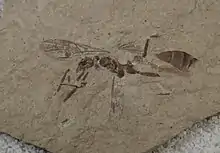
- Proteinus
- Pselaptrichus
- Pseudips
- Pseudips concinnus (syn=Ips concinnus)
- Pseudohylesinus
- Pseudopsis
- Aff. †Pseudopsis sulcata
- Pterostichus
- †Pterostichus adstrictus
- †Pterostichus castaneus
- †Pterostichus fernquisti – type locality for species
- †Pterostichus pumilus
- †Pterostichus riparius
- Pteryngium
- †Pteryngium crenatum
- Pycnoglypta
- †Pycnoglypta campbelli
Arthropods Q
Arthropods R
- Ranina
- †Ranina americana
- Raninoides
- Reichenbachia
- †Republica - type locality for genus
- †Republica weatbrooki - type locality for species[136]
- †Republicopteron - type locality for genus
- †Republicopteron douseae - type locality for species[137]
- Rhantus
- †Rhizocorallium
- †Rhizocorallium jenense[90]
- Indeterminate Chuckanut Formation Rhizocorallium insect burrow[90]
- Rhyncolus
- †Rhyncolus brunneus
Arthropods S
- Saldula
- Scaphinotus
- Sitona
- Sonoma
- †Stenodiafanus - type locality for genus
- †Stenodiafanus westersidei - type locality for species[113]
- Stenus
- Stephostethus
- Steremnius
- †Steremnius carinatus
- †Steremnius tuberosus
- Sthereus
- †Sthereus multituberculatus
- †Sthereus quadrituberculatus
- Syntomium
- Cf. †Syntomium malkini
- Syntomus
Arthropods T
- Tachinus
- †Taenidium
- Indeterminate Cuckanut Formation Taenidium type burrows[90]
- Tetrascapha
- Undescribed Klaloch site subfossils[103]
- Thanatophilus
- Tipula
- †Tipula latahensis – type locality for species[108]
- Tournotaris
- Cf. Trechiama
- Trechus
- Trechus (Trechus) chalybeus[103]
- Trechus (Trechus) oregonensis[103][105]
- Cf. Trechus ovipennis[105]
- Trichalophus
- Trichopeltarion
- †Trichopeltarion berglundorum[111]
- Trypophloeus
- †Trypophloeus salicis[103]
Arthropods U
Arthropods W
- †Whetwhetaksa - Type locality of the genus
- †Whetwhetaksa millerae - Type locality of the species[113]
Arthropods Y
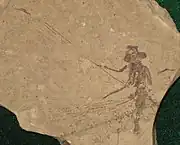
Ypshna brownleei
- †Ypshna
- †Ypshna brownleei - Type locality of the species[109]
Arthropods Z
- †Zanthopsis
- †Zanthopsis vulgaris[91]
"Fish"

Fossilized skeleton found in Republic belonging to the Eocene-Oligocene sucker fish Amyzon aggregatum
- Acipenser
- Acrocheilus
- †Acrocheilus latus[140]
- Ameiurus
- †Ameiurus reticulatus – type locality for species[140]
- Archoplites
- †Archoplites molarus – type locality for species[140]
- †Aglyptorhynchus
- †Aglyptorhynchus columbianus – type locality for species
- Amia
- †Amyzon[141]
- Catostomus
- Chasmistes
- Diaphus?
- tentatively identified Chattian Lincoln Creek Formation fossil(s)[142]
- Esox
- †Esox columbianus – type locality for species[140]
- †Eosalmo[141]
- †Gyrace
- †Gyrace occidentalis (syn=Squalus occidentalis)[143]
- Heptranchias
- Hiodon
- Isurus
- Tentatively reported Undescribed Ypresian Crescent Formation fossil
- Klamathella
- †Klamathella milleri[140]
- Lavinia
- †Lavinia hibbardi[140]
- †Libotonius
- Mitsukurina
- undescribed middle Eocene Puget Group Tukwila Formation fossil(s)[91]
- Mylocheilus
- †Mylocheilus heterodon - type locality for species[140]
- Nolorhynchus
- Oncorhynchus
- †Oxygoniolepidus - type locality for genus
- †Oxygoniolepidus washingtonensis - type locality for species[146]
- †Palaeohypotodus
- Undescribed Ypresian Crescent Formation fossil[147]
- †Phareodus
- Indeterminate Early Eocene Chuckanut Formation fossil[148]
- †Priscacara
- †Priscacara campi – type locality for species
- †Probathygadus - type locality for genus
- †Probathygadus keaseyensis - type locality for species[146]
- Ptychocheilus
- †Ptychocheilus arciferus[140]
- †Rhinoscymnus
- †Rhinoscymnus viridadama - type locality for species[149]
- Somniosus
- †Somniosus gonzalezi - type locality for species[149]
- †Triaenodon
- undescribed middle Eocene Puget Group Tukwila Formation fossil(s)[91]
Birds
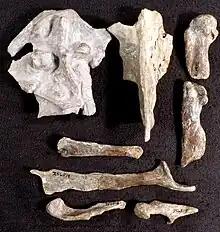
- †Ardeipeda
- Indeterminate Chuckanut Formation Gruipedidae wading bird tracks[150]
- †Avipeda
- Indeterminate Chuckanut Formation Avipedidae wading bird tracks[150]
- †Charadriipeda
- Indeterminate Chuckanut Formation webbed bird tracks[150]
- †Diomedavus - type locality for genus
- †Diomedavus knapptonensis - type locality for species[93]
- †Klallamornis - type locality for genus
- †Klallamornis abyssa - type locality for species[151]
- †Klallamornis buchanani (syn=Tonsala buchanani[152]) – type locality for species[153]
- †Klallamornis clarki - type locality for species[151]
- †Makahala - type locality for genus
- †Makahala mirae - type locality for species[154]
- †Ornithoformipes - type locality for genus
- †Ornithoformipes controversus - type locality for species[155]
- †Olympidytes - type locality for genus
- †Olympidytes thieli - type locality for species[151]
- †Rivavipes - type locality for genus
- †Rivavipes giganteus - type locality for species[156]
- †Tonsala – type locality for genus
- †Tonsala hildegardae – type locality for species[157]
Reptiles

Acherontemys heckmani holotype
- †Acherontemys – type locality for genus
- †Acherontemys heckmani – type locality for species[158]
- †Anticusuchipes
- †Anticusuchipes amnis - type locality for species[159]
- Charina
- †Chelonipus
- Indeterminate Chuckanut Formation turtle tracks[159]
- Crotalus
- Indeterminate Blancan Ringold Formation "Taunton fauna" subfossil(s)[160]
- Elaphe
- †Elaphe pliocenica
- Lampropeltis
- Pantherophis
- Pantherophis vulpinus (syn=Elaphe vulpina)
- Pituophis

A living Thamnophis, or garter snake
- †Tauntonophis – type locality for genus
- †Tauntonophis morganorum – type locality for species[160]
- Thamnophis
- Undescribed Pliocene Ringold Formation "Taunton fauna" subfossil(s)[160]
- Trionyx
- Indeterminate Early Eocene Chuckanut Formation fossil[148]
- †Wilburemys – type locality for genus
- †Wilburemys yakimensis – type locality for species[161]
Mammals
Mammals A
- †Alilepus
- †Alilepus vagus
- Cf. †Alilepus wilsoni
- †Allodesmus
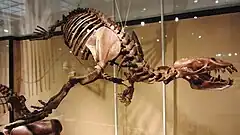 Fossilized skeleton of the Miocene seal Allodesmus
Fossilized skeleton of the Miocene seal Allodesmus- †Allodesmus demerei - type locality for species[162]
- undescribed Oligocene Pysht Formation fossils of possible Allodesmus affinity.
- Ammospermophilus
- †Ammospermophilus hanfordi[163]
- Cf. Antecalomys
- Indeterminate Wilbur site fossils[161]
- †Aphelops
- Cf. †Aphelops mutilus
Mammals B
- Bassariscus
- Cf. †Bassariscus casei
- †Behemotops – type locality for genus
- †Behemotops proteus – type locality for species
- Bison
- Bison antiquus[164]
- Undescribed Late Pleistocene Manis Mastodon site subfossil[1]
- †Borealodon – type locality for genus
- †Borealodon osedax – type locality for species[165]
- †Borophagus
 Restoration of two of the Miocene-Pliocene bone-crushing dog genus Borophagus preying on a camel. Jay Matternes (1964).
Restoration of two of the Miocene-Pliocene bone-crushing dog genus Borophagus preying on a camel. Jay Matternes (1964). - †Bretzia
- †Bretzia pseudalces – type locality for species
- undescribed Early Pliocene Ellensburg Formation fossil(s)[166]
- †Buisnictis
- †Buisnictis breviramus
Mammals C
- †Camelops
 Life restoration of the Pliocene-Holocene camel Camelops
Life restoration of the Pliocene-Holocene camel Camelops- Indeterminate Irvingtonian Delight site, Adams County subfossil[167]
- Indeterminate Blancan Ringold Formation fossil
- Canis
- †Capromeryx
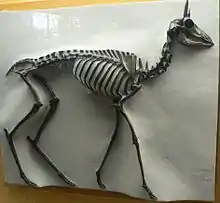 Panel-Fossilized skeleton of the Pleistocene dwarf pronghorn Capromeryx
Panel-Fossilized skeleton of the Pleistocene dwarf pronghorn Capromeryx- †Capromeryx tauntonensis – type locality for species
- Castor
- †Castor californicus
- Indeterminate Wilbur Site fossils[161]
- Cervus
- †Cervus brevitrabalis
- †Copemys
- Indeterminate Wilbur Site fossils[161]
- †Cormocyon
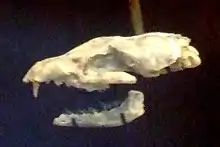 Fossilized skull of the Oligocene-Miocene bone-crushing dog Cormocyon
Fossilized skull of the Oligocene-Miocene bone-crushing dog Cormocyon- †Cormocyon copei
- †Cosoryx
- †Cosoryx (Subcosoryx) cerroensis
- †Cranioceras
 Restoration of the Miocene palaeomerycid Cranioceras, a relative of modern deer, with anachronistic human to scale
Restoration of the Miocene palaeomerycid Cranioceras, a relative of modern deer, with anachronistic human to scale- Cf. †Cranioceras unicornis
- †Cynarctus
- †Cynarctus crucidens
Mammals D
- †Desmatophoca
- †Desmatophoca brachycephala – type locality for species
- †Desmostylus
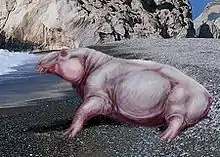 Life restoration of the Oligocene-Miocene herbivorous marine mammal Desmostylus
Life restoration of the Oligocene-Miocene herbivorous marine mammal Desmostylus - †Diceratherium
- †Diceratherium annectens
- "Blue lake rhino" - unidentified species preserved as a cast in basalt[168]
- †Dinofelis
- Cf. †Dinofelis palaeoonca
- †Dipoides
- †Dipoides rexroadensis
- †Dipoides wilsoni[161]
Mammals E
- †Enhydrocyon
- Undescribed Monroecreekian Wildcat Creek beds fossil
- †Eporeodon
- Undescribed Monroecreekian Wildcat Creek beds fossil
- Equus
- †Eucyon
Mammals F
- †Fucaia – type locality for genus
- †Fucaia buelli – type locality for species
- †Fucaia goedertorum – type locality for species
Mammals H
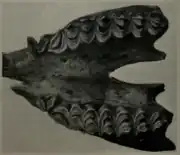
Fossilized lower jaw of the Miocene-Pleistocene llama relative Hemiauchenia
- †Hemiauchenia
- †Hipparion
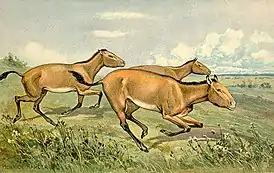 Life restoration of a herd of the Miocene-Pleistocene horse Hipparion. Heinrich Harder (1920).
Life restoration of a herd of the Miocene-Pleistocene horse Hipparion. Heinrich Harder (1920).- †Hipparion condoni[161]
- †Hoplictis
- †Hoplictis grangerensis
- †Hypertragulus
- Undescribed Monroecreekian Wildcat Creek beds fossil
- †Hypolagus
Mammals K
- †Kolponomos
- Aff. †Kronokotherium
- Undescribed Miocene Clallam Formation fossil.
- Undescribed Late Eocene Pysht Formation fossil.[169]
Mammals L

A living Lynx
- †Leptarctus
- Undescribed Clarendonian Ellensburg Formation fossil[170]
- Lynx
Mammals M

Life restorations of a Mammut americanum, or American mastodon (right), and a Mammuthus primigenius, or wooly mammoth (left)
- †Mammut
- †Mammuthus
- †Megalonyx
- †Megatylopus
- Cf. †Megatylopus cochrani[163]
- Indeterminate Wilbur site fossils[161]
- †Merycoides
- †Mesoreodon
- †Mimomys
- †Mimomys mcknighti
- †Mimomys taylori
- †Miohippus
- Cf. †Miohippus equiceps
- †Miohippus equinanus? – tentative report
- Mirounga
- Mustela
- Cf. †Mustela rexroadensis
Mammals N
Mammals O
.png.webp)
Olympicetus thalassodon
- Odocoileus
- †Olympicetus - type locality for genus
- Ondatra
- †Ondatra minor
Mammals P
- †Paenemarmota
- Cf. †Paenemarmota sawrockensis
- Cf. †Palaeolagus
- †Paracryptotis
- †Paracryptotis rex
- †Paraenhydrocyon
- †Parailurus
- †Paramylodon
 Fossilized skeleton of the Pliocene-Pleistocene ground sloth Paramylodon
Fossilized skeleton of the Pliocene-Pleistocene ground sloth Paramylodon - †Paronychomys
- Peromyscus
 A living Peromyscus, or deer mouse
A living Peromyscus, or deer mouse- †Peromyscus nosher
- Perognathus
- Indeterminate Wilbur site fossil[161]
- Phenacomys
- †Platygonus
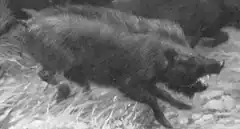 Restoration of a herd of alarmed Miocene-Pleistocene peccaries of the genus Platygonus. Charles R. Knight (1922).
Restoration of a herd of alarmed Miocene-Pleistocene peccaries of the genus Platygonus. Charles R. Knight (1922).- †Platygonus pearcei
- †Plionarctos
- †Plionarctos harroldorum – type locality for species
- †Pliosaccomys
- †Pliosaccomys prowitteorum - type locality for species[161]
- †Pliotaxidea
- †Pliotaxidea nevadensis[161]
- †Procastoroides
- Cf. †Procastoroides idahoensis
- Procyon – tentative report
- †Prodipodomys
- †Promerycochoerus
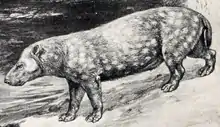
- †Promerycochoerus superbus
- †Prosthennops
- Pterynotus
- †Pterynotus washingtonicus – type locality for species
- Puma
- Puma concolor? – tentative report
- †Puma lacustris (syn=Felis lacustris)
Mammals R
Mammals S
- †Salishicetus - type locality for genus
- †Salishicetus meadi - type locality for species[174]
- †Satherium
- Scapanus
- †Sitsqwayk
- †Sitsqwayk cornishorum – type locality for species
- Sorex
 A living Sorex, or long-tailed shrew
A living Sorex, or long-tailed shrew- Cf. †Sorex meltoni
- †Sorex powersi
- Spermophilus
- Spilogale
- †Squaloziphius – type locality for genus
- †Squaloziphius emlongi – type locality for species
Mammals T
- Taxidea
- Taxidea taxus - subfossil
- †Teleoceras
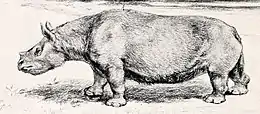 Restoration of the Miocene-Pliocene rhinoceros Teleoceras
Restoration of the Miocene-Pliocene rhinoceros Teleoceras- †Teleoceras hicksi
- Cf. †Teleoceras major
- Thomomys
- Cf. †Thomomys gidleyi[175]
- Undescribed Pliocene Ringold Formation fossil[175]
- †Trigonictis
- †Trigonictis cookii
- †Trigonictis macrodon
Mammals W-Z
- †Wimahl - type locality for genus
- †Wimahl chinookensis - type locality for species[176]
- †Zarhinocetus
- †Zarhinocetus donnamatsonae – type locality for species[177]
Notes
References
- 1 2 3 4 5 6 7 8 9 10 11 12 13 14 15 16 17 18 19 20 21 22 23 24 25 26 27 Petersen, K. L.; Mehringer, P. J. Jr; Gustafson, C. E. (1983). "Late-glacial vegetation and climate at the Manis mastodon site, Olympic Peninsula, Washington". Quaternary Research. 20 (2): 215–231. Bibcode:1983QuRes..20..215P. doi:10.1016/0033-5894(83)90078-9. S2CID 129281439.
- 1 2 3 4 5 6 7 8 9 10 11 12 13 14 15 16 17 18 19 20 21 22 23 24 25 26 27 28 29 30 31 32 33 34 35 36 37 38 39 40 41 42 43 44 45 46 47 48 49 50 51 52 53 54 55 56 57 58 59 60 61 62 63 64 65 66 67 68 69 70 71 72 73 74 75 76 77 Mann, A. (1926). "The fossil diatom deposit at Spokane. In: Flora of the Latah Formation of Spokane, Washington, and Coeur d'Alene, Idaho". Shorter contributions to general geology, 1925 (PDF) (Report). Professional Paper. Vol. 140. United States Geological Survey. pp. 51–55, plates XXX-XXXI. doi:10.3133/pp140A.
- 1 2 3 LaMotte, R.S. (1952). Catalogue of the Cenozoic plants of North America through 1950. Geological Society of America Memoirs. Vol. 51. Geological Society of America. doi:10.1130/MEM51.
- 1 2 3 Miller, N. G. (1980). "Fossil mosses of North America and their significance". The Mosses of North America. pp. 9–36.
- 1 2 3 4 5 6 7 Knowlton, F.H. (1926). "Flora of the Latah Formation of Spokane, Washington, and Coeur d'Alene, Idaho". Shorter contributions to general geology, 1925 (PDF) (Report). Professional Paper. Vol. 140. United States Geological Survey. pp. 17–55, plates VIII-XXXI. doi:10.3133/pp140A.
- 1 2 3 4 5 6 7 8 LaMotte, R.S. (1952). Catalogue of the Cenozoic plants of North America through 1950. Geological Society of America Memoirs. Vol. 51. Geological Society of America. doi:10.1130/MEM51.
- 1 2 3 4 5 6 7 8 9 10 11 12 13 14 15 16 17 18 19 20 21 22 23 Pabst, M. B. (1968). "The flora of the Chuckanut Formation—the Equisitales. Filicales, and Coniferales". University of California Publications in Geological Sciences. 76 (85).
- 1 2 3 4 5 6 7 8 9 10 11 12 13 14 15 16 17 18 19 20 21 22 23 24 25 26 27 28 29 30 31 32 33 34 35 36 37 38 39 40 Wolfe, J.A. (1968), "Paleogene Biostratigraphy of Nonmarine Rocks in King County, Washington", United States Geological Survey Bulletin, 571: 1–29
- 1 2 3 4 5 6 7 8 9 10 11 12 13 14 15 16 17 18 19 20 21 22 23 24 25 26 27 28 29 30 31 32 33 34 35 36 37 Dillhoff, R.M.; Dillhoff, T.A.; Jijina, A.P.; Strömberg, C.A.E. (2014). "The Vasa Park flora, King County, Washington, USA – a window into the late Miocene of the Pacific Northwest". In Stevens, W.D.; Montiel, O.M.; Raven, P.H. (eds.). Paleobotany and Biogrography, A Festschrift for Alan Graham in His 80th Year. Missouri Botanical Garden Press. pp. 64–97.
- ↑ Arnold, C. A. (1955). "A Tertiary Azolla from British Columbia" (PDF). Contributions from the Museum of Paleontology, University of Michigan. 12 (4): 37–45.
- 1 2 Wolfe, J.A. (1977). Paleogene floras from the Gulf of Alaska region (Report). Professional Paper. Vol. 997. United States Geological Survey. pp. 1–108. doi:10.3133/pp997.
- 1 2 3 4 5 6 7 8 9 Wehr, W. "Middle Eocene insects and plants of the Okanogan Highlands". In Martin, J. (ed.). Contributions to the Paleontology and Geology of the West Coast. Seattle, Washington: University of Washington Press. pp. 99–109.
- 1 2 Pigg, K. B.; DeVore, M. L.; Greenwood, D. R.; Sundue, M. A.; Schwartsburd, P.; Basinger, J. F. (2021). "Fossil Dennstaedtiaceae and Hymenophyllaceae from the Early Eocene of the Pacific Northwest". International Journal of Plant Sciences. 182 (9): 793–807. doi:10.1086/715633. S2CID 239036762.
- 1 2 3 4 5 6 7 8 9 10 11 12 13 14 15 16 Brown, R. W. (1937). Additions to some fossil floras of the Western United States (PDF) (Report). Professional Paper. Vol. 186. United States Geological Survey. pp. 163–206. doi:10.3133/pp186J.
- ↑ Joseph, N. L. (1988). "Important Eocene Flora and Fauna Unearthed at Republic, Washington". Rocks & Minerals. 63 (2): 146–151. Bibcode:1988RoMin..63..146J. doi:10.1080/00357529.1988.11761830.
- 1 2 NW palms
- 1 2 3 4 5 6 7 8 9 10 11 12 13 14 Greenwood, D.R.; Archibald, S.B.; Mathewes, R.W; Moss, P.T. (2005). "Fossil biotas from the Okanagan Highlands, southern British Columbia and northeastern Washington State: climates and ecosystems across an Eocene landscape". Canadian Journal of Earth Sciences. 42 (2): 167–185. Bibcode:2005CaJES..42..167G. doi:10.1139/e04-100.
- 1 2 Miller, C.N. jr. (1982). "Osmunda wehrii, a New Species Based on Petrified Rhizomes from the Miocene of Washington". American Journal of Botany. 69 (1): 116–121. doi:10.2307/2442836. JSTOR 2442836.
- 1 2 Greenwood, D.R.; Pigg, K.B.; Basinger, J.F.; DeVore, M.L. (2016). "A review of paleobotanical studies of the Early Eocene Okanagan (Okanogan) Highlands floras of British Columbia, Canada, and Washington, U.S.A." Canadian Journal of Earth Sciences. 53 (6): 548–564. Bibcode:2016CaJES..53..548G. doi:10.1139/cjes-2015-0177. hdl:1807/71961.
- ↑ Scott, R. A.; Barghoorn, E. S.; Prakash, U. (1962). "Wood of Ginkgo in the Tertiary of western North America". American Journal of Botany. 49 (10): 1095–1101. doi:10.1002/j.1537-2197.1962.tb15052.x. JSTOR 2439157.
- 1 2 Mustoe, G.E. (2002). "Eocene Ginkgo leaf fossils from the Pacific Northwest". Canadian Journal of Botany. 80 (10): 1078–1087. doi:10.1139/b02-097.
- 1 2 3 4 5 6 7 8 9 10 11 12 13 14 15 16 17 18 Dillhoff, R.M.; Leopold, E.B.; Manchester, S.R. (2005). "The McAbee flora of British Columbia and its relations to the Early-Middle Eocene Okanagan Highlands flora of the Pacific Northwest" (PDF). Canadian Journal of Earth Sciences. 42 (2): 151–166. Bibcode:2005CaJES..42..151D. doi:10.1139/e04-084.
- ↑ Mathewes, R. W.; Greenwood, D. R.; Archibald, S. B. (2016). "Paleoenvironment of the Quilchena flora, British Columbia, during the Early Eocene Climatic Optimum" (PDF). Canadian Journal of Earth Sciences. 53 (6): 574–590. Bibcode:2016CaJES..53..574M. doi:10.1139/cjes-2015-0163. hdl:1807/71979.
- 1 2 3 4 5 6 7 8 9 10 Schorn, H. E.; Wehr, W. C. (1996). "The conifer flora from the Eocene uplands at Republic, Washington". Washington Geology. 24 (2): 22–24.
- 1 2 3 "Conifers and Ginkgos". Burke Museum Paleobotany Project. Retrieved 28 May 2023.
- 1 2 3 4 5 6 7 8 9 10 11 12 13 14 15 16 17 18 19 20 21 22 23 24 25 26 27 Wheeler, E.; Dillhoff, T. (2009). "The Middle Miocene Wood Flora of Vantage, Washington, USA". IAWA Journal. Supplement 7: 101.
- ↑ LePage, B. A. (2007). "The taxonomy and biogeographic history of Glyptostrobus Endlicher (Cupressaceae)". Bulletin of the Peabody Museum of Natural History. 48 (2): 359–426. doi:10.3374/0079-032x(2007)48[359:ttabho]2.0.co;2. S2CID 128968431.
- ↑ Chaney, R.W. (1951). "A revision of fossil Sequoia and Taxodium in western North America based on the recent discovery of Metasequoia". Transactions of the American Philosophical Society. 40 (3): 231.
- 1 2 3 4 5 6 7 8 9 10 11 12 13 14 15 Berry, E.W. (1929). A revision of the flora of the Latah formation (Report). Professional Paper. United States Geological Survey. pp. 225–265. doi:10.3133/pp154h. 154-H.
- 1 2 3 Prakash, U. (1968). "Miocene fossil woods from the Columbia basalts of Central Washington, III". Palaeontographica Abteilung B. 122 (4–6): 183–200.
- ↑ Kvaček, Z.; Manchester, S.; Schorn, H. (2000). "Cones, seeds, and foliage of Tetraclinis salicornioides (Cupressaceae) from the Oligocene and Miocene of western North America: a geographic extension of the European Tertiary species". International Journal of Plant Sciences. 161 (2): 331–344. doi:10.1086/314245. PMID 10777457. S2CID 3191378.
- 1 2 3 4 5 6 7 8 9 10 11 12 13 Chaney, R.; Axelrod, D. (1959). Miocene Floras of the Columbia Plateau: Part II. Systematic Considerations, by Ralph W. Chaney and Daniel I. Axelrod. Carnegie Institution of Washington. pp. 1–226.Miocene Floras of the Columbia Plateau at the HathiTrust Digital Library
- ↑ Schorn, Howard; Wehr, Wesley (1986). "Abies milleri, sp. nov., from the Middle Eocene Klondike Mountain Formation, Republic, Ferry County, Washington". Burke Museum Contributions in Anthropology and Natural History (1): 1–7.
- ↑ Brown, R. (1935). "Miocene leaves, fruits, and seeds from Idaho, Oregon, and Washington". Journal of Paleontology. 9: 572–587.
- ↑ Gooch, N. L. (1992). "Two new species of Pseudolarix Gordon (Pinaceae) from the middle Eocene of the Pacific Northwest". PaleoBios. 14: 13–19.
- 1 2 Berry, E.W. (1932). "A Miocene flora from Grand Coulee, Washington". Shorter contributions to general geology, 1931 (Report). Professional Paper. United States Geological Survey. pp. 31–42. doi:10.3133/pp170C. 170-C.
- ↑ Shi, G.; Zhou, Z.; Xie, Z. (2010). "A new Cephalotaxus and associated epiphyllous fungi from the Oligocene of Guangxi, South China". Review of Palaeobotany and Palynology. 161 (3–4): 179–195. Bibcode:2010RPaPa.161..179S. doi:10.1016/j.revpalbo.2010.04.002.
- 1 2 3 4 5 6 7 8 9 10 11 12 13 14 Prakash, U.; Barghoorn, E. S. (1961). "Miocene fossil woods from the Columbia Basalts of central Washington". Journal of the Arnold Arboretum. 42 (2): 165–203. doi:10.5962/bhl.part.19013.
- 1 2 3 4 5 6 7 8 9 10 11 12 13 14 15 Hoffman, A.D. (1932). "The Douglas Canyon flora of east central Washington". Journal of Geology. 40 (8): 735–738. Bibcode:1932JG.....40..735H. doi:10.1086/623995. S2CID 128889896.
- 1 2 3 4 5 6 7 8 9 10 11 12 13 14 15 Wolfe, J.A.; Tanai, T. (1987). "Systematics, Phylogeny, and Distribution of Acer (maples) in the Cenozoic of Western North America". Journal of the Faculty of Science, Hokkaido University. Series 4, Geology and Mineralogy. 22 (1): 23, 74, 75, 240, & plate 4.
- 1 2 3 4 5 Prakash, U.; Barghoorn, E. S. (1961). "Miocene fossil woods from the Columbia Basalts of central Washington, II". Journal of the Arnold Arboretum. 42 (3): 347–362. doi:10.5962/bhl.part.19013.
- ↑ Harris, A. J.; Papes, M.; Gao, Y. D.; Watson, L. (2014). "Estimating paleoenvironments using ecological niche models of nearest living relatives: A case study of Eocene Aesculus L.". Journal of Systematics and Evolution. 52 (1): 16–34. doi:10.1111/jse.12053. S2CID 83926177.
- 1 2 3 4 5 6 7 8 9 10 11 12 13 14 15 16 17 18 19 20 21 22 23 24 25 26 Wolfe, J.A.; Wehr, W.C. (1987). "Middle Eocene dicotyledonous plants from Republic, northeastern Washington". United States Geological Survey Bulletin. 1597: 1–25.
- 1 2 3 4 5 6 7 8 9 10 11 12 13 14 15 Wehr, W. C.; Hopkins, D. Q. (1994). "The Eocene orchards and gardens of Republic, Washington". Washington Geology. 22 (3): 27–34.
- ↑ Wang, Q.; Manchester, S. R.; Gregor, H. J.; Shen, S.; Li, Z. Y. (2013). "Fruits of Koelreuteria (Sapindaceae) from the Cenozoic throughout the northern hemisphere: their ecological, evolutionary, and biogeographic implications". American Journal of Botany. 100 (2): 422–449. doi:10.3732/ajb.1200415. PMID 23360930.
- ↑ Herendeen, P. S.; Dilcher, D. L. (1991). "Caesalpinia subgenus Mezoneuron (Leguminosae, Caesalpinioideae) from the Tertiary of North America". American Journal of Botany. 78 (1): 1–12. doi:10.1002/j.1537-2197.1991.tb12566.x. JSTOR 2445223.
- 1 2 3 4 5 6 7 8 9 10 Wehr, W.C. (1995). "Early Tertiary flowers, fruits and seeds of Washington State and adjacent areas". Washington Geology. 23 (3): 3–16.
- 1 2 3 4 Wehr, W.C. (1995). "Paleobotanical Significance of Eocene Flowers, Fruits, and Seeds from Republic, Washington". Washington Geology. 24 (2): 25–2.
- 1 2 3 4 5 Pigg, K.B.; Manchester, S.R.; Wehr, W.C. (2003). "Corylus, Carpinus, and Palaeocarpinus (Betulaceae) from the Middle Eocene Klondike Mountain and Allenby Formations of Northwestern North America". International Journal of Plant Sciences. 164 (5): 807–822. doi:10.1086/376816. S2CID 19802370.
- ↑ Manchester, S.R. (1987). "The fossil history of the Juglandaceae". Monographs in Systematic Botany. 21: 1–137.
- 1 2 3 Radtke, M.G.; Pigg, K.B.; Wehr, W.C. (2005). "Fossil Corylopsis and Fothergilla Leaves (Hamamelidaceae) from the Lower Eocene Flora of Republic, Washington, U.S.A., and Their Evolutionary and Biogeographic Significance". International Journal of Plant Sciences. 166 (2): 347–356. doi:10.1086/427483. S2CID 20215269.
- ↑ Manchester, S. R. (1991). "Cruciptera, a new Juglandaceous winged fruit from the Eocene and Oligocene of western North America". Systematic Botany. 16 (4): 715–725. doi:10.2307/2418873. JSTOR 2418873.
- 1 2 Müller-Stoll, W. R.; Mädel, E. (1967). "Die fossilen Leguminosen-Hölzer. Eine Revision der mit Leguminosen verglichenen fossilen Hölzer und Beschreibungen älterer und neuer Arten". Palaeontographica Abteilung B. 119 (4–6): 95–174.
- ↑ Manchester, S.; Pigg, K. (2008). "The Eocene mystery flower of McAbee, British Columbia". Botany. 86 (9): 1034–1038. doi:10.1139/B08-044.
- ↑ McClain, A. M.; Manchester, S. R. (2001). "Dipteronia (Sapindaceae) from the Tertiary of North America and implications for the phytogeographic history of the Aceroideae". American Journal of Botany. 88 (7): 1316–25. doi:10.2307/3558343. JSTOR 3558343. PMID 11454632.
- ↑ Call, V.B.; Dilcher, D.L. (1997). "The fossil record of Eucommia (Eucommiaceae) in North America". American Journal of Botany. 84 (6): 798–814. doi:10.2307/2445816. JSTOR 2445816. PMID 21708632. S2CID 20464075.
- 1 2 3 4 Brown, R.W. (1946). "Alterations in some fossil and living floras". Journal of the Washington Academy of Sciences. 36 (10): 344–355.
- ↑ Manchester, S. R.; Dillhoff, R. M. (2004). "Fagus (Fagaceae) fruits, foliage, and pollen from the Middle Eocene of Pacific Northwestern North America". Canadian Journal of Botany. 82 (10): 1509–1517. doi:10.1139/b04-112.
- ↑ Manchester, S. R. (1992). "Flowers, fruits and pollen of Florissantia, an extinct malvalean genus from the Eocene and Oligocene of western North America". American Journal of Botany. 79 (9): 996–1008. doi:10.2307/2444909. JSTOR 2444909.
- 1 2 3 DeVore, M. L.; Pigg, K. B. (2007). "A brief review of the fossil history of the family Rosaceae with a focus on the Eocene Okanogan Highlands of eastern Washington State, USA, and British Columbia, Canada". Plant Systematics and Evolution. 266 (1–2): 45–57. Bibcode:2007PSyEv.266...45D. doi:10.1007/s00606-007-0540-3. S2CID 10169419.
- ↑ Wang, Q.; Manchester, S. R.; Gregor, H. J.; Shen, S.; Li, Z. Y. (2013). "Fruits of Koelreuteria (Sapindaceae) from the Cenozoic throughout the northern hemisphere: their ecological, evolutionary, and biogeographic implications". American Journal of Botany. 100 (2): 422–449. doi:10.3732/ajb.1200415. PMID 23360930. S2CID 23810529.
- ↑ Huegele, I. B.; Manchester, S. R. (26 April 2022). "Newly Recognized Reproductive Structures Linked with Langeria from the Eocene of Washington, USA, and their Affinities with Platanaceae". International Journal of Plant Sciences. 183 (5): 000. doi:10.1086/720138. S2CID 247907696.
- ↑ Pigg, K. B.; Ickert-Bond, S. M.; Wen, J. (2004). "Anatomically preserved Liquidambar (Altingiaceae) from the middle Miocene of Yakima Canyon, Washington state, USA, and its biogeographic implications". American Journal of Botany. 91 (3): 499–509. doi:10.3732/ajb.91.3.499. PMID 21653405.
- ↑ Baghai, N.L. (1988). "Liriodendron (Magnoliaceae) from the Miocene Clarkia flora of Idaho". American Journal of Botany. 75 (4): 451–464. doi:10.1002/j.1537-2197.1988.tb13463.x.
- ↑ Burnham, R.J. (1994). Paleoecological and Floristic Heterogeneity in the Plant-Fossil Record - An Analysis Based on the Eocene of Washington (Report). Bulletin. United States Geological Survey. pp. 1–36. doi:10.3133/b2085B. hdl:2027/mdp.39015095145341. 2085-B.
- ↑ Manchester, S. R.; Crane, P. R.; Dilcher, D. L. (1991). "Nordenskioldia and Trochodendron fruits (Trochodendraceae) from the Miocene of northwestern North America". Botanical Gazette. 152: 357–368. doi:10.1086/337898. S2CID 84230472.
- ↑ DeVore, ML; Taylor, W; Pigg, KB (2015). "Nuphar carlquistii sp. nov. (Nymphaeaceae): A Water Lily from the Latest Early Eocene, Republic, Washington". International Journal of Plant Sciences. 176 (4): 365–377. doi:10.1086/680482. S2CID 84149074.
- 1 2 3 4 Berry, E.W. (1931). "A Miocene flora from Grand Coulee, Washington". Shorter contributions to general geology, 1931 (Report). Professional Paper. United States Geological Survey. pp. 31–42. doi:10.3133/pp170C. 170-C.
- 1 2 Benedict, JC; DeVore, ML; Pigg, KB (2011). "Prunus and Oemleria (Rosaceae) Flowers from the Late Early Eocene Republic Flora of Northeastern Washington State, U.S.A.". International Journal of Plant Sciences. 172 (7): 948–958. doi:10.1086/660880. S2CID 39391439.
- ↑ Bogner, J.; Johnson, K. R.; Kvacek, Z.; Upchurch, G. R. (2007). "New fossil leaves of Araceae from the Late Cretaceous and Paleogene of western North America" (PDF). Zitteliana. A (47): 133–147. ISSN 1612-412X.
- ↑ Pigg, K. B.; Bryan, F. A.; DeVore, M. L. (2018). "Paleoallium billgenseli gen. et sp. nov.: Fossil Monocot Remains from the Latest Early Eocene Republic Flora, Northeastern Washington State, USA". International Journal of Plant Sciences. 179 (6): 477–486. doi:10.1086/697898. S2CID 91055581.
- ↑ Burge, D.O.; Manchester, S.R. (2008). "Fruit morphology, fossil history, and biogeography of Paliurus (Rhamnaceae)". International Journal of Plant Sciences. 169 (8): 1066–1085. doi:10.1086/590453. S2CID 84886094.
- ↑ Li, X.; Wang, H.; Leng, Q.; Xiao, L.; Guo, J.; He, W. (2014). "Paliurus (Paliureae, Rhamnaceae) from the Miocene of East China and its Macrofossil-based Phylogenetic and Phytogeographical History". Acta Geologica Sinica (English Edition). 88 (5): 1364–1377. Bibcode:2014AcGlS..88.1364L. doi:10.1111/1755-6724.12304. S2CID 129463506.
- ↑ Manchester, S. R.; Kvaček, Z.; Judd, W. S. (2020). "Morphology, anatomy, phylogenetics and distribution of fossil and extant Trochodendraceae in the Northern Hemisphere". Botanical Journal of the Linnean Society. 195 (3): 467–484. doi:10.1093/botlinnean/boaa046.
- 1 2 3 Manchester, S.; Pigg, K. B.; Kvaček, Z; DeVore, M. L.; Dillhoff, R. M. (2018). "Newly recognized diversity in Trochodendraceae from the Eocene of western North America". International Journal of Plant Sciences. 179 (8): 663–676. doi:10.1086/699282. S2CID 92201595.
- 1 2 3 Pigg, K.; Wehr, W.C. (2002). "Early Tertiary flowers, fruits and seeds of Washington State and adjacent areas Part-III". Washington Geology. 30 (3–4): 3–16.
- ↑ Huegele, I.B.; Spielbauer, R.J.; Manchester, S.R. (2020). "Morphology and systematic affinities of Platanus dissecta Lesquereux (Platanaceae) from the Miocene of western North America". International Journal of Plant Sciences. 181 (3): 324–341. doi:10.1086/706453. S2CID 208566485.
- ↑ Huegele, I.B.; Zhu, H.; Zhao, B.; Wang, Y.-F.; Manchester, S. R. (2021). "Trans-Beringial Distribution of Platimeliphyllum (Platanaceae) in the Eocene of Eastern Asia and Western North America". International Journal of Plant Sciences. 183 (2): 139–153. doi:10.1086/717692. S2CID 239529168.
- ↑ Kvaček, Z.; Dašková, J.; Zetter, R. (2004). "A re-examination of Cenozoic Polypodium in North America". Review of Palaeobotany and Palynology. 128 (3–4): 219–227. Bibcode:2004RPaPa.128..219K. doi:10.1016/s0034-6667(03)00134-9.
- ↑ Smith, M. A.; Greenwalt, D. E.; Manchester, S. R. (2023). "Diverse fruits and seeds of the mid-Eocene Kishenehn Formation, northwestern Montana, USA, and their implications for biogeography" (PDF). Fossil Imprint. 79 (1): 37–88. doi:10.37520/fi.2023.004. S2CID 265087120.
- ↑ Manchester, S.R. (1994). "Fruits and Seeds of the Middle Eocene Nut Beds Flora, Clarno Formation, Oregon". Palaeontographica Americana. 58: 30–31.
- ↑ Borgardt, S. J.; Pigg, K. B. (1999). "Anatomical and developmental study of petrified Quercus (Fagaceae) fruits from the Middle Miocene, Yakima Canyon, Washington, USA". American Journal of Botany. 86 (3): 307–325. doi:10.2307/2656753. JSTOR 2656753. PMID 10077494.
- 1 2 3 4 Flynn, S.; DeVore, M. L.; Pigg, K. B. (2019). "Morphological Features of Sumac Leaves (Rhus, Anacardiaceae), from the Latest Early Eocene Flora of Republic, Washington". International Journal of Plant Sciences. 180 (6): 464–478. doi:10.1086/703526. S2CID 198244783.
- 1 2 3 Blokhina, N. I. (2007). "Fossil wood of the Juglandaceae: Some questions of taxonomy, evolution, and phylogeny in the family based on wood anatomy" (PDF). Paleontological Journal. 41 (11): 1040–1053. Bibcode:2007PalJ...41.1040B. doi:10.1134/s0031030107110032. S2CID 86299157.
- 1 2 Pigg, K. B.; DeVore, M. L. (2005). "Shirleya grahamae gen. et sp. nov.(Lythraceae), Lagerstroemia-like fruits from the middle Miocene Yakima Canyon flora, central Washington State, USA". American Journal of Botany. 92 (2): 242–251. doi:10.3732/ajb.92.2.242. PMID 21652401.
- ↑ Soomro, N.; Arain, B. A.; Rajput, M. T. M. (2016). "Albizzioxylon chinjiensis sp. nov., a new fossil species of the family Leguminosae from Chinji formation salt range, Punjab Pakistan". International Journal. 11 (28): 2838–2843.
- ↑ Pigg, K.B.; Wehr, W.C.; Ickert-Bond, S.M. (2001). "Trochodendron and Nordenskioldia (Trochodendraceae) from the Middle Eocene of Washington State, U.S.A". International Journal of Plant Sciences. 162 (5): 1187–1198. doi:10.1086/321927. S2CID 45399415.
- 1 2 Denk, T.; Dillhoff, R.M. (2005). "Ulmus leaves and fruits from the Early-Middle Eocene of northwestern North America: systematics and implications for character evolution within Ulmaceae" (PDF). Canadian Journal of Botany. 83 (12): 1663–1681. doi:10.1139/b05-122. Archived from the original (PDF) on 2017-08-09. Retrieved 2018-06-05.
- 1 2 3 4 Pigg, K.B. (2001). "Anatomically preserved Woodwardia virginica (Blechnaceae) and a new Filicalean fern from the Middle Miocene Yakima Canyon Flora of central Washington, USA". American Journal of Botany. 88 (5): 777–787. doi:10.2307/2657030. JSTOR 2657030. PMID 11353703.
- 1 2 3 4 5 6 Mustoe, G.E. (2022). "Invertebrate trace fossils from Paleogene fluvial strata in Western Washington, USA". Ichnos. 29 (3–4): 148–165. Bibcode:2022Ichno..29..148M. doi:10.1080/10420940.2023.2182295. S2CID 257251180.
- 1 2 3 4 5 6 7 8 9 10 11 12 13 14 15 16 17 18 19 20 21 22 23 24 25 26 27 28 29 30 31 32 33 34 35 36 37 38 39 40 41 42 43 44 45 46 47 48 49 50 51 52 53 54 55 56 57 58 59 60 61 62 63 64 65 66 67 68 69 70 71 72 73 Nesbitt, E. (1998). "Marine fauna of the middle Eocene Tukwila Formation, King County". Washington Geology. 26 (1): 13–19.
- 1 2 Goedert, J.; Squires, R.; Barnes, L. (1995). "Paleoecology of whale-fall habitats from deep-water Oligocene rocks, Olympic Peninsula, Washington State". Palaeogeography, Palaeoclimatology, Palaeoecology. 118 (1–2): 151–158. Bibcode:1995PPP...118..151G. doi:10.1016/0031-0182(94)00139-Y. hdl:10211.3/195768.
- 1 2 Mayr, G.; Goedert, J. (2017). "Oligocene and Miocene albatross fossils from Washington State (USA) and the evolutionary history of North Pacific Diomedeidae". The Auk. 134 (3): 659–671. doi:10.1642/AUK-17-32.1. S2CID 89636332.
- 1 2 3 4 5 Goedert, J.L.; Guthrie, L. S.; Kiel, S. (2022). "Octocorals (Alcyonacea and Pennatulacea) from Paleogene deep-water strata in western Washington State, USA". Journal of Paleontology. 96 (3): 539–551. Bibcode:2022JPal...96..539G. doi:10.1017/jpa.2022.5.
- ↑ Moore, E.J. (1984). "Molluscan paleontology and biostratigraphy of the Lower Miocene upper part of the Lincoln Creek Formation in southwestern Washington". Contributions in Science, Natural History Museum of Los Angeles County. 351: 1–42.
- 1 2 3 4 5 6 7 Kiel, s.; Goedert, J. (2007). "New mollusks associated with biogenic substrates in Cenozoic deep?water sediments of Washington State". Acta Palaeontologica Polonica. 52 (1): 41–52.
- ↑ Kiel, S. (2008). "An unusual new gastropod from an Eocene hydrocarbon seep in Washington state". Journal of Paleontology. 82 (1): 188–191. Bibcode:2008JPal...82..188K. doi:10.1666/06-029.1. S2CID 131151474.
- 1 2 3 4 5 Weaver, C. E. (1942). "Paleontology of the Marine Tertiary formations of Oregon and Washington". University of Washington Publications in Geology. 5: 1–789.
- ↑ Moore, E. (2003). Tertiary marine pelecypods of California and Baja California: Crassatellidae through Pharidae (Report). Professional Paper. Vol. 1228. United States Geological Survey. pp. 1–107.
- 1 2 Addicott, W.O. (1976). Molluscan paleontology of the lower Miocene Clallam Formation, northwestern Washington. United States Geological Survey (Report). Professional Paper. Vol. 976. pp. 1–44.
- 1 2 3 Durham, J. W. (1944). "Megafaunal zones of the Oligocene of northwestern Washington". University of California Publications in Geological Sciences. 27: 101–212.
- ↑ Weaver, C. E.; Palmer, K. (1922). "Fauna from the Eocene of Washington". University of Washington Publications in Geology. 1 (3): 1–56.
- 1 2 3 4 5 6 7 8 9 10 11 12 13 14 15 16 17 18 19 20 21 22 23 Cong, S.G.; Ashworth, A.C. (1996). "Palaeoenvironmental interpretation of Middle and Late Wisconsinan fossil coleopteran assemblages from western Olympic Peninsula, Washington, USA". Journal of Quaternary Science. 11 (5): 345–356. Bibcode:1996JQS....11..345C. doi:10.1002/(SICI)1099-1417(199609/10)11:5<345::AID-JQS259>3.0.CO;2-A.
- ↑ Vladimir N. Makarkin; S. Bruce Archibald (2013). "A Diverse New Assemblage of Green Lacewings (Insecta, Neuroptera, Chrysopidae) from the Early Eocene Okanagan Highlands, Western North America". Journal of Paleontology. 87 (1): 123–146. Bibcode:2013JPal...87..123M. doi:10.1666/12-052R.1. S2CID 130797848.
- 1 2 3 4 5 6 7 8 9 10 11 12 13 14 15 16 17 18 19 20 21 22 Ashworth, A.C.; Nelson, R.E. (2014). "The paleoenvironment of the Olympia beds based on fossil beetles from Discovery Park, Seattle, Washington, U.S.A.". Quaternary International. 341: 243–254. Bibcode:2014QuInt.341..243A. doi:10.1016/j.quaint.2013.09.022.
- ↑ Makarkin, V.; Archibald, S.B. (2014). "An unusual new fossil genus probably belonging to the Psychopsidae (Neuroptera) from the Eocene Okanagan Highlands, western North America" (PDF). Zootaxa. 3838 (3): 385–391. CiteSeerX 10.1.1.692.1185. doi:10.11646/zootaxa.3838.3.8. PMID 25081783.
- ↑ Vladimir N. Makarkin & S. Bruce Archibald (2009). "A new genus and first Cenozoic fossil record of moth lacewings (Neuroptera: Ithonidae) from the Early Eocene of North America" (PDF). Zootaxa. 2063: 55–63. doi:10.11646/zootaxa.2063.1.3. S2CID 13922025.
- 1 2 3 Lewis, S.E. (1969). "Fossil insects of the Latah Formation (Miocene) of eastern Washington and northern Idaho". Northwest Science. 43: 99–115.
- 1 2 3 Archibald, S. B.; Cannings, R. A. (2019). "Fossil dragonflies (Odonata: Anisoptera) from the early Eocene Okanagan Highlands, western North America". The Canadian Entomologist. 151 (6): 783–816. doi:10.4039/tce.2019.61.
- 1 2 3 Lewis, S.E. (1992). "Insects of the Klondike Mountain Formation, Republic, Washington". Washington Geology. 20 (3): 15–19.
- 1 2 3 4 5 Fraaije, R. H.; van Bakel, B. W.; Jagt, J. W.; Coole, Y. (2006). "Two new Paleogene species of mud shrimp (Crustacea, Decapoda, Upogebiidae) from Europe and North America". Bulletin of the Mizunami Fossil Museum. 33: 77–85.
- 1 2 3 4 Archibald, S.B. (2005). "New Dinopanorpidae (Insecta: Mecoptera) from the Eocene Okanagan Highlands (British Columbia, Canada and Washington State, USA)". Canadian Journal of Earth Sciences. 42 (2): 119–136. Bibcode:2005CaJES..42..119A. doi:10.1139/e04-073. S2CID 55513480.
- 1 2 3 4 5 6 7 8 9 10 Archibald, S. B.; Cannings, R. A.; Erickson, R. J.; Bybee, S. M.; Mathewes, R. W. (2021). "The Cephalozygoptera, a new, extinct suborder of Odonata with new taxa from the early Eocene Okanagan Highlands, western North America". Zootaxa. 4934 (1): zootaxa.4934.1.1. doi:10.11646/zootaxa.4934.1.1. PMID 33756770.
- ↑ Andrei A. Legalov (2013). "New and little known weevils (Coleoptera: Curculionoidea) from the Paleogene and Neogene". Historical Biology: An International Journal of Paleobiology. 25 (1): 59–80. Bibcode:2013HBio...25...59L. doi:10.1080/08912963.2012.692681. S2CID 86584002.
- ↑ Archibald, SB; Bradler, S (2015). "Stem-group stick insects (Phasmatodea) in the early Eocene at McAbee, British Columbia, Canada, and Republic, Washington, United States of America". The Canadian Entomologist. 147 (6): 744. doi:10.4039/tce.2015.2. S2CID 86608533.
- ↑ Archibald, S. B.; Rasnitsyn, A. P.; Brothers, D. J.; Mathewes, R. W. (2018). "Modernisation of the Hymenoptera: ants, bees, wasps, and sawflies of the early Eocene Okanagan Highlands of western North America". The Canadian Entomologist. 150 (2): 205–257. doi:10.4039/tce.2017.59. ISSN 0008-347X. S2CID 90017208.
- ↑ Archibald, S. B.; Rasnitsyn, A. P. (2022). "The early Eocene Eourocerus anguliterreus gen. et sp. nov (Hymenoptera, Siricidae) from Republic, Washington". Zootaxa. 5105 (2): 289–295. doi:10.11646/zootaxa.5105.2.8. PMID 35391300. S2CID 247240762.
- ↑ Legalov, A. A. (2015). "Fossil Mesozoic and Cenozoic weevils (Coleoptera, Obrienioidea, Curculionoidea)". Paleontological Journal. 49 (13): 1442–1513. Bibcode:2015PalJ...49.1442L. doi:10.1134/S0031030115130067. S2CID 87912009.
- ↑ Dlussky, G. M.; Rasnitsyn, A. P. (2003). "Ants (Hymenoptera: Formicidae) of Formation Green River and some other Middle Eocene deposits of North America". Russian Entomological Journal. 11 (4): 411–436.
- 1 2 3 Archibald, S. B.; Rasnitsyn, A. P. (2023). "Cimbicidae (Hymenoptera, "Symphyta") in the Paleogene: revision, the new subfamily Cenocimbicinae, and new taxa from the Eocene Okanagan Highlands". Zootaxa. 5278 (1): 1–38. doi:10.11646/zootaxa.5278.1.1. PMID 37518298. S2CID 258492775.
- ↑ Archibald, S. B.; Makarkin, V. N. (2021). "Early Eocene snakeflies (Raphidioptera) of western North America from the Okanagan Highlands and Green River Formation". Zootaxa. 4951 (1): 41–79. doi:10.11646/zootaxa.4951.1.2. PMID 33903413. S2CID 233411745.
- 1 2 3 Schweitzer, C. E.; Iturralde-Vinent, M.; Hetler, J. L.; Velez-Juarbe, J. (2006). "Oligocene and Miocene decapods (Thalassinidea and Brachyura) from the Caribbean". Annals of Carnegie Museum. 75 (2): 111–136. doi:10.2992/0097-4463(2006)75[111:oamdta]2.0.co;2. S2CID 53496359.
- ↑ Ross E. Berglund & James L. Goedert (1996). "A new crab (Brachyura: Cancridae) from Lower Miocene rocks of the Northwestern Olympic Peninsula, Washington". Journal of Paleontology. 70 (5): 830–835. Bibcode:1996JPal...70..830B. doi:10.1017/S0022336000023866. JSTOR 1306484. S2CID 132189245.
- ↑ Archibald, SB; Kehlmaier, C; Mathewes, RW (2014). "Early Eocene big headed flies (Diptera: Pipunculidae) from the Okanagan Highlands, western North America". The Canadian Entomologist. 146 (4): 429–443. doi:10.4039/tce.2013.79. S2CID 55738600.
- 1 2 Nyborg, T.; Garassino, A. (2015). "New fossil squat lobsters (Crustacea: Anomura: Munididae) from the Eastern Pacific". Palaeodiversity. 8: 95–101.
- ↑ Archibald, S.B.; Cover, S. P.; Moreau, C. S. (2006). "Bulldog Ants of the Eocene Okanagan Highlands and History of the Subfamily (Hymenoptera: Formicidae: Myrmeciinae)" (PDF). Annals of the Entomological Society of America. 99 (3): 487–523. doi:10.1603/0013-8746(2006)99[487:BAOTEO]2.0.CO;2.
- ↑ Sinitchenkova, N. D. (1999). "A new mayfly species of the extant genus Neoephemera from the Eocene of North America (Insecta: Ephemerida=Ephemeroptera)" (PDF). Paleontological Journal. 33 (4): 403–405. Archived from the original (PDF) on 2011-09-30.
- ↑ Archibald, S. B.; Makarkin, V. N.; Ansorge, J. (2009). "New fossil species of Nymphidae (Neuroptera) from the Eocene of North America and Europe" (PDF). Zootaxa. 2157: 59–68. doi:10.11646/zootaxa.2157.1.4. S2CID 9304328.
- ↑ Perfilieva, K. S.; Dubovikoff, D. A.; Dlussky, G. M. (2017). "Miocene ants (Hymenoptera, Formicidae) from Crimea". Paleontological Journal. 51 (4): 391–401. Bibcode:2017PalJ...51..391P. doi:10.1134/s0031030117040098. S2CID 90536477.
- 1 2 3 4 5 Nyborg, T.; Garassino, A.; Nyborg, B. (2023). "A new fossil frog crab (Brachyura, Lyreididae) from the Eocene of northeastern Pacific". Neues Jahrbuch für Geologie und Paläontologie - Abhandlungen. 307 (1): 29–39. doi:10.1127/njgpa/2023/1110. S2CID 256754390.
- ↑ Makarkin, V.N.; Archibald, S.B.; Mathewes, R.W. (2021). "New Protosmylinae (Neuroptera: Osmylidae) from the early Eocene of western North America, with taxonomic remarks". Zootaxa. 4980 (1): 142–156. doi:10.11646/zootaxa.4980.1.9. PMID 34186986. S2CID 235685548.
- ↑ Karasawa, H.; Fudouji, Y. (2018). "Two new species of hermit crabs (Decapoda: Anomura) from the Paleogene Kishima Group, Saga Prefecture, Japan". Bulletin of the Mizunami Fossil Museum. 44: 23–28.
- 1 2 3 4 5 Archibald, S.B.; Makarkin V.N. (2006). "Tertiary Giant Lacewings (Neuroptera: Polystechotidae): Revision and Description of New Taxa From Western North America and Denmark". Journal of Systematic Palaeontology. 4 (2): 119–155. Bibcode:2006JSPal...4..119A. doi:10.1017/S1477201906001817. S2CID 55970660. Archived from the original on June 4, 2011. Retrieved January 27, 2010.
- ↑ Vladimir N. Makarkin; Sonja Wedmann; Thomas Weiterschan (2016). "A new genus of Hemerobiidae (Neuroptera) from Baltic amber, with a critical review of the Cenozoic Megalomus-like taxa and remarks on the wing venation variability of the family". Zootaxa. 4179 (3): 345–370. doi:10.11646/zootaxa.4179.3.2. PMID 27811679. S2CID 27743454.
- ↑ Dlussky, G. M.; Rasnitsyn, A. P. (1999). "Two new species of aculeate hymenopterans (Vespida=Hymenoptera) from the Middle Eocene of the United States". Paleontological Journal. 33: 546–549.
- ↑ Archibald, S. B.; Cannings, R. A. (2021). "A new genus and species of Euphaeidae (Odonata, Zygoptera) from the early Eocene Okanagan Highlands locality at Republic, Washington, U.S.A.". Zootaxa. 4966 (3): 392–400. doi:10.11646/zootaxa.4966.3.11. PMID 34186607. S2CID 235557114.
- ↑ Archibald, S. B.; Gu, J.-J.; Mathewes, R. W. (2022). "The Palaeorehniidae (Orthoptera, Ensifera, "Zeuneropterinae"), and new taxa from the early Eocene Okanagan Highlands, western North America". Zootaxa. 5100 (4): 559–572. doi:10.11646/zootaxa.5100.4.6. PMID 35391059. S2CID 247046978.
- ↑ Snyder, T.E. (1949). "A new Miocene Ulmeriella (fossil Isoptera, Hodotermitidae)". Proceedings of the Entomological Society of Washington. 51 (4): 164–165.
- 1 2 Archibald, S.B.; Rasnitsyn, A.P. (2015). "New early Eocene Siricomorpha (Hymenoptera: Symphyta: Pamphiliidae, Siricidae, Cephidae) from the Okanagan Highlands, western North America". The Canadian Entomologist. 148 (2): 209–228. doi:10.4039/tce.2015.55. S2CID 85743832.
- 1 2 3 4 5 6 7 8 9 10 Smith, G. R.; Morgan, N.; Gustafson, E. (2000). Fishes of the Mio-Pliocene Ringold Formation, Washington: Pliocene capture of the Snake River by the Columbia River (PDF) (Report). Papers on Paleontology. Vol. 32. Museum of Paleontology, The University of Michigan. pp. 1–47.
- 1 2 3 4 5 Wilson, MVH (1977). "Middle Eocene freshwater fishes from British Columbia". Life Sciences Contributions, Royal Ontario Museum. 113: 1–66.
- ↑ Peckmann, J.; Goedert, J.; Thiel, V.; Michaelis, W.; Reitners, J. (2002). "A comprehensive approach to the study of methane-seep deposits from the Lincoln Creek Formation, western Washington State, USA". Sedimentology. 49 (4): 855–873. Bibcode:2002Sedim..49..855P. doi:10.1046/j.1365-3091.2002.00474.x. S2CID 129510183.
- ↑ Bigelow, P. (1994). "Occurrence of a squaloid shark (Chondrichthyes: Squaliformes) with the pinniped Allodesmus from the Upper Miocene of Washington". Journal of Paleontology. 68 (3): 680–684. Bibcode:1994JPal...68..680B. doi:10.1017/S0022336000026032. S2CID 131209899.
- ↑ Hilton, E. J.; Grande, L. (2008). "Fossil Mooneyes (Teleostei: Hiodontiformes, Hiodontidae) from the Eocene of western North America, with a reassessment of their taxonomy". Geological Society, London, Special Publications. 295 (1): 221–251. Bibcode:2008GSLSP.295..221H. doi:10.1144/sp295.13. S2CID 128680041.
- ↑ Wilson, M. V. H. (1979). "A Second Species of Libotonius (Pisces: Percopsidae) from the Eocene of Washington State". Copeia. 1979 (3): 400–405. doi:10.2307/1443214. JSTOR 1443214.
- 1 2 David, L. (1956). "Tertiary Anacanthin Fishes from California and the Pacific Northwest; Their Paleoecological Significance". Journal of Paleontology. 30 (30): 568–607.
- ↑ Squires, R.L.; Goedert, J.L. (1994). "Macropaleontology of the Eocene Crescent Formation in the Little River Area, Southern Olympic Peninsula, Washington". Contributions in Science (Natural History Museum of Los Angeles County). 444: 1–32.
- 1 2 Mustoe, G.E. (2023). "The First Discovery of a Fish Fossil (Phareodus s p.) from Paleogene Fluvial Deposits in Western Washington State, USA". Geosciences. 13 (9): 255. Bibcode:2023Geosc..13..255M. doi:10.3390/geosciences13090255.
- 1 2 Welton, B.; Goedert, J. (2016). "New fossil species of Somniosus and Rhinoscymnus (Squaliformes: Somniosidae), deep water sharks from Oligocene rocks of Western Washington State, USA". Fossil Record. 5: 309–326.
- 1 2 3 Mustoe, G.E. (2002). "Eocene bird, reptile, and mammal tracks from the Chuckanut Formation, northwest Washington" (PDF). PALAIOS. 17 (4): 403–413. Bibcode:2002Palai..17..403M. doi:10.1669/0883-1351(2002)017<0403:EBRAMT>2.0.CO;2. S2CID 128743331.
- 1 2 3 Mayr, G.; Goedert, J. (2016). "New Late Eocene and Oligocene Remains of the Flightless, Penguin-Like Plotopterids (Aves, Plotopteridae) from Western Washington State, U.S.A.". Journal of Vertebrate Paleontology. 36 (4): e1163573. Bibcode:2016JVPal..36E3573M. doi:10.1080/02724634.2016.1163573. S2CID 88129671.
- ↑ Mayr, G.; Goedert, J. (2021). "New late Eocene and Oligocene plotopterid fossils from Washington State (USA), with a revision of "Tonsala" buchanani (Aves, Plotopteridae)". Journal of Paleontology. 96: 224–236. doi:10.1017/jpa.2021.81. S2CID 240582610.
- ↑ Dyke, G.; Wang, Wang; Habib, M. (2011). "Fossil Plotopterid Seabirds from the Eo-Oligocene of the Olympic Peninsula (Washington State, USA): Descriptions and Functional Morphology". PLOS ONE. 6 (10): e25672. Bibcode:2011PLoSO...625672D. doi:10.1371/journal.pone.0025672. PMC 3204969. PMID 22065992.
- ↑ Mayr, G. (2015). "A new Paleogene procellariiform bird from western North America". Neues Jahrbuch für Geologie und Paläontologie - Abhandlungen. 275 (1): 11–17. doi:10.1127/njgpa/2015/0445.
- ↑ Patterson, J; Lockley, M. G. (2004). "A probable Diatryma track from the Eocene of Washington: an intriguing case of controversy and skepticism". Ichnos. 11 (3–4): 341–347. Bibcode:2004Ichno..11..341P. doi:10.1080/10420940490442278.
- ↑ Mustoe, G. E.; Tucker, D. S.; Kemplin, K. L. (2012). "Giant Eocene bird footprints from northwest Washington, USA". Palaeontology. 55 (6): 1293–1305. Bibcode:2012Palgy..55.1293M. doi:10.1111/j.1475-4983.2012.01195.x.
- ↑ Olson, S. (1980). "A new genus of penguin-like pelecaniform bird from the Oligocene of Washington (Pelecaniformes: Plotopteridae)". Contributions in Science. 330: 51–57. doi:10.5962/p.208144. S2CID 4803730.
- ↑ Hay, O. P. (1899). "Descriptions of two new species of tortoise from the Tertiary of the United States". Proceedings of the U.S. National Museum. 22 (1181): 21–24. doi:10.5479/si.00963801.22-1181.21.
- 1 2 Mustoe, G.E. (2019). "Lower Eocene footprints from northwest Washington, USA. Part 1: Reptile tracks". Geosciences. 9 (321): 1–19. Bibcode:2019Geosc...9..321M. doi:10.3390/geosciences9070321.
- 1 2 3 Parmley, D.; Walker, D. (2003). "Snakes of the Pliocene Taunton local fauna of Adams County, Washington with the description of a new colubrid". Journal of Herpetology. 37 (2): 235–244. doi:10.1670/0022-1511(2003)037[0235:SOTPTL]2.0.CO;2. S2CID 86000331.
- 1 2 3 4 5 6 7 8 9 10 11 12 13 14 15 Martin, J. E.; Mallory, V. S. (2011). "Vertebrate paleontology of the late Miocene (Hemphillian) Wilbur Locality of central Washington". Paludicola. 8 (3): 155–185.
- ↑ Boessenecker, R.; Churchill, M. (2018). "The last of the desmatophocid seals: a new species of Allodesmus from the upper Miocene of Washington, USA, and a revision of the taxonomy of Desmatophocidae". Zoological Journal of the Linnean Society. 184 (1): 211–235. doi:10.1093/zoolinnean/zlx098.
- 1 2 3 4 Gustafson, E.P. (1978). "The Vertebrate Faunas of the Pliocene Ringold Formation, South-Central Washington". Bulletin of the Museum of Natural History, University of Oregon. 23: 1–62.
- ↑ Wilson, M. C.; Kenady, S. M.; Schalk, R. F. (2009). "Late Pleistocene Bison antiquus from Orcas Island, Washington, and the biogeographic importance of an early postglacial land mammal dispersal corridor from the mainland to Vancouver Island". Quaternary Research. 71 (1): 49–61. Bibcode:2009QuRes..71...49W. doi:10.1016/j.yqres.2008.09.001. S2CID 129543840.
- ↑ B. K. Shipps; Carlos Mauricio Peredo; Nicholas D. Pyenson (2019). "Borealodon osedax, a new stem mysticete (Mammalia, Cetacea) from the Oligocene of Washington State and its implications for fossil whale-fall communities". Royal Society Open Science. 6 (7): Article ID 182168. Bibcode:2019RSOS....682168S. doi:10.1098/rsos.182168. PMC 6689636. PMID 31417706.
- ↑ Emery-Wetherell, M.; Schilter, J. (2020). "A new early occurrence of Cervidae in North America from the Miocene-Pliocene Ellensburg Formation in Washington, USA". Palaeontologia Electronica. 23 (a08).
- ↑ Fry, W.; Gustafson, E. (1974). "Cervids from the Pliocene and Pleistocene of Central Washington". Journal of Paleontology. 48 (2).
- ↑ Chappell, W.; Durham, J.; Savage, D. (1951). "Mold of a rhinoceros in basalt, Lower Grand Coulee, Washington". Geological Society of America Bulletin. 62 (8): 907–918. doi:10.1130/0016-7606(1951)62[907:MOARIB]2.0.CO;2.
- ↑ Barnes, L.G.; Goedert, J.L. (2001). "Stratigraphy and paleoecology of Oligocene and Miocene desmostylian occurrences in western Washington State, USA". Bulletin of Ashoro Museum of Paleontology. 2: 7–22.
- ↑ Martin, J.E.; Pagnac, D.C. (2009). "A Vertebrate Assemblage From the Miocene Rattlesnake Ridge Member of the Ellensburg Formation, Central Washington.". In Albright, L. B. (ed.). Papers on Geology, Vertebrate Paleontology, and Biostratigraphy in Honor of Michael O. Woodburne (Museum of Northern Arizona Bulletin 65). pp. 197–216.
- ↑ Rick, T.; DeLong, R.; Erlandson, J.; Braje, T.; Jones, T.; Arnold, J.; Des Lauriers, M.; Hildebrandt, W.; Kennett, D.; Vellanoweth, R.; Wake, T. (2011). "Where were the northern elephant seals? Holocene archaeology and biogeography of Mirounga angustirostris". The Holocene. 21 (7): 1159–1166. Bibcode:2011Holoc..21.1159R. doi:10.1177/0959683611400463. S2CID 129322617.
- ↑ Vélez-Juarbe, J. (2017). "A new stem odontocete from the late Oligocene Pysht Formation in Washington State, U.S.A.". Journal of Vertebrate Paleontology. 37 (5): e1366916. Bibcode:2017JVPal..37E6916V. doi:10.1080/02724634.2017.1366916. S2CID 90151706.
- ↑ Velez-Juarbe, J. (2023). "New heterodont odontocetes from the Oligocene Pysht Formation in Washington State, U.S.A., and a reevaluation of Simocetidae (Cetacea, Odontoceti)". PeerJ. 11: e15576. doi:10.7717/peerj.15576. PMC 10292202. PMID 37377790.
- ↑ Peredo, C.; Pyenson, N. (2018). "Salishicetus meadi, a new aetiocetid from the late Oligocene of Washington State and implications for feeding transitions in early mysticete evolution". Royal Society Open Science. 5 (4): 172336. Bibcode:2018RSOS....572336P. doi:10.1098/rsos.172336. PMC 5936946. PMID 29765681.
- 1 2 Morgan, J. K.; Morgan, N. H. (1995). "A New Species of Capromeryx (Mammalia: Artiodactyla) from the Taunton Local Fauna of Washington, and the Correlation with Other Blancan Faunas of Washington and Idaho". Journal of Vertebrate Paleontology. 15 (1): 160–170. Bibcode:1995JVPal..15..160M. doi:10.1080/02724634.1995.10011215.
- ↑ Peredo, C.; Uhen, M.; Nelson, M. (2018). "A new kentriodontid (Cetacea: Odontoceti) from the early Miocene Astoria Formation and a revision of the stem delphinidan family Kentriodontidae". Journal of Vertebrate Paleontology. 38 (2): e1411357. Bibcode:2018JVPal..38E1357P. doi:10.1080/02724634.2017.1411357. S2CID 89965454.
- ↑ Kimura, T; Barnes, L. (2016). "New Miocene fossil Allodelphinidae (Cetacea, Odontoceti, Platanistoidea) from the North Pacific Ocean". Bulletin of the Gunma Museum of Natural History. 20: 1–58.
Uncited entries
- "Fossilworks: Gateway to the Paleobiology Database". Retrieved 7 August 2017.
This article is issued from Wikipedia. The text is licensed under Creative Commons - Attribution - Sharealike. Additional terms may apply for the media files.

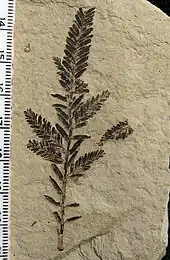
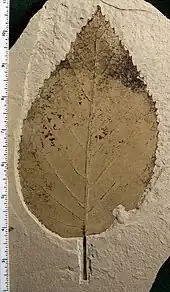
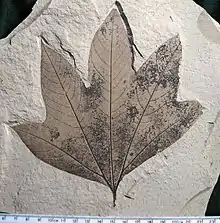

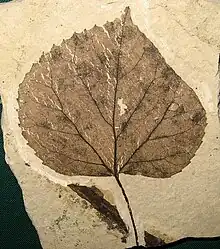
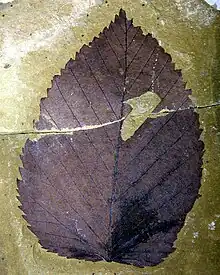
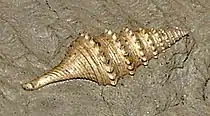
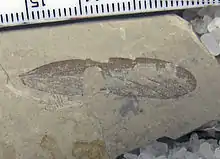

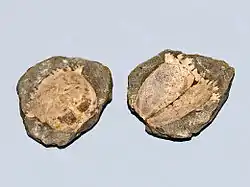

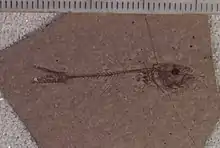
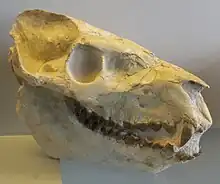
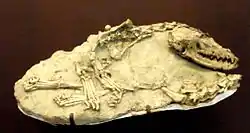
.jpg.webp)